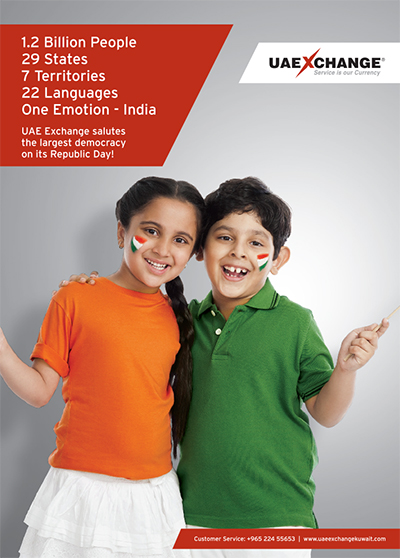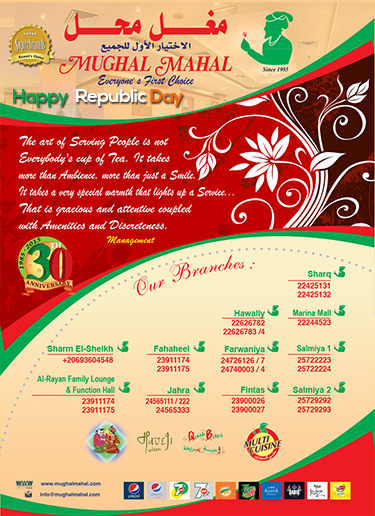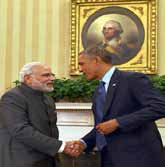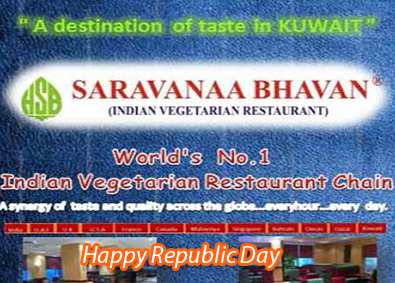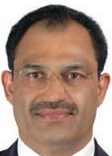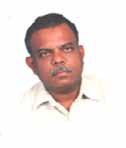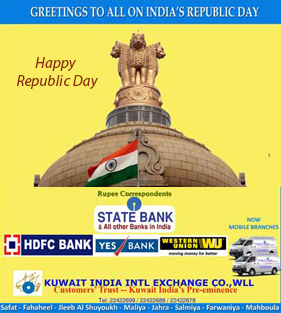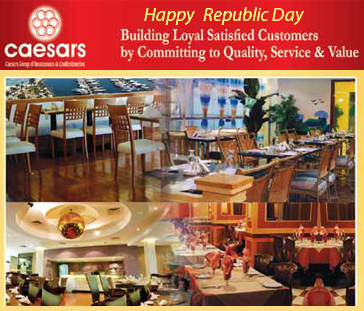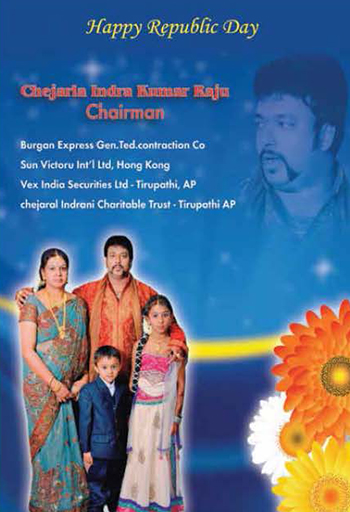Indian Republic Day 2015 Special
ADDRESS BY THE PRESIDENT OF INDIA
ON THE EVE OF THE REPUBLIC DAY OF INDIA
2015 New Delhi: Jan 25, 2015
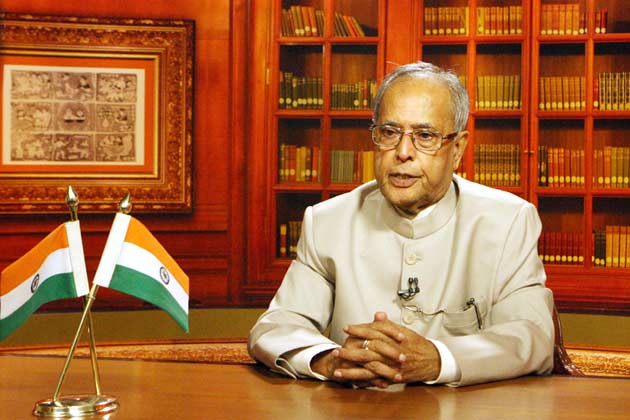
My Fellow Citizens:
1. On the eve of the 66th Republic Day, I extend warm greetings to all of you in India and abroad. I convey my special greetings to members of our Armed Forces, Paramilitary Forces and Internal Security Forces.
2. Twenty Sixth January holds an everlasting place in our national memory because it is the day when modern India was born. Under Mahatma Gandhi’s moral and political leadership, the National Congress passed the Purna Swaraj resolution demanding complete independence from British rule in December 1929. Gandhiji organized nationwide celebrations on 26 January 1930 as Independence Day. From then on, the Nation took a pledge on this day every year to carry on the freedom struggle till we attained it.
3. Exactly twenty years later, in 1950, we adopted our charter of modernity, the Constitution. Tragically, Gandhiji had been martyred two years before, but the framework of a Constitution that has made India a role model for today's world was constructed out of his philosophy. Its essence lay in four principles: democracy; freedom of faith; gender equality; and an economic upsurge for those trapped in the curse of dire poverty. These were made Constitutional obligations. Gandhiji’s talisman for the country's rulers was simple and powerful and I quote: "Whenever you are in doubt...recall the face of the poorest and the weakest man whom you may have seen and ask yourself...will it lead to swaraj for the hungry and spiritually starving millions?" (unquote). Our resolve to eliminate poverty through inclusive development has to be a step in that direction.
Fellow Citizens:
4. The past year has been remarkable in many ways. Particularly because, after three decades the people have voted to power a single party with a majority for a stable government, and in the process freed the country’s governance from the compulsions of coalition politics. Outcome of these Elections has given the mandate to the elected government to fulfill its commitment to the people by using its majority for formulating policies and making laws to implement those policies. The voter has played her part; it is now up to those who have been elected to honour this trust. It was a vote for clean, efficient, effective, gender-sensitive, transparent, accountable and citizen-friendly governance. Fellow Citizens: 5. There can be no governance without a functioning legislature. The legislature reflects the will of the people. It is the platform where progressive legislation using civilized dialogue must create delivery mechanisms for realizing the aspirations of the people. It calls for reconciling the differences amongst stakeholders and building a consensus for the law to be enacted. Enacting laws without discussion impacts the law-making role of the Parliament. It breaches the trust reposed in it by the people. This is neither good for the democracy nor for the policies relating to those laws.
Fellow Citizens:
 6. Pandit Jawaharlal Nehru, Sardar Patel, Subhash Chandra Bose, Bhagat Singh, Rabindranath Tagore, Subramanya Bharati and many more - the vocation and the approach might have been different but they all spoke the same language of patriotism. We owe our freedom to these great warriors of nationalism. We also salute the unsung heroes who have died securing the liberation of Mother India. But it pains me to see that Mother India is not respected by her own children when it comes to the safety of women. Atrocities of rape, murders, harassment on the roads, kidnapping and dowry deaths have made women fearful even in their own homes. Rabindranath Tagore saw women not only as the deities of the household fire, but also the flame of the soul itself. Where have we failed, as parents, teachers and leaders, that our children have forgotten all tenets of decent behaviour and respect for women? We have enacted many legislations but, as Benjamin Franklin had once said and I quote: “Justice will not be served until those who are unaffected are as outraged as those who are” (unquote). Every Indian must take a pledge to protect the honour of women from violence of any kind. Only a nation that respects and empowers its women can become a global power.
6. Pandit Jawaharlal Nehru, Sardar Patel, Subhash Chandra Bose, Bhagat Singh, Rabindranath Tagore, Subramanya Bharati and many more - the vocation and the approach might have been different but they all spoke the same language of patriotism. We owe our freedom to these great warriors of nationalism. We also salute the unsung heroes who have died securing the liberation of Mother India. But it pains me to see that Mother India is not respected by her own children when it comes to the safety of women. Atrocities of rape, murders, harassment on the roads, kidnapping and dowry deaths have made women fearful even in their own homes. Rabindranath Tagore saw women not only as the deities of the household fire, but also the flame of the soul itself. Where have we failed, as parents, teachers and leaders, that our children have forgotten all tenets of decent behaviour and respect for women? We have enacted many legislations but, as Benjamin Franklin had once said and I quote: “Justice will not be served until those who are unaffected are as outraged as those who are” (unquote). Every Indian must take a pledge to protect the honour of women from violence of any kind. Only a nation that respects and empowers its women can become a global power.
Fellow Citizens:
7. The Indian Constitution is the holy book of democracy. It is a lodestar for the socio-economic transformation of an India whose civilization has celebrated pluralism, advocated tolerance and promoted goodwill between diverse communities. These values, however, need to be preserved with utmost care and vigilance. The freedom inherent in democracy sometimes generates an unhappy by-product when political discourse becomes a competition in hysteria that is abhorrent to our traditional ethos. The violence of the tongue cuts and wounds people's hearts. Religion, said Gandhiji, is a force for unity; we cannot make it a cause of conflict.
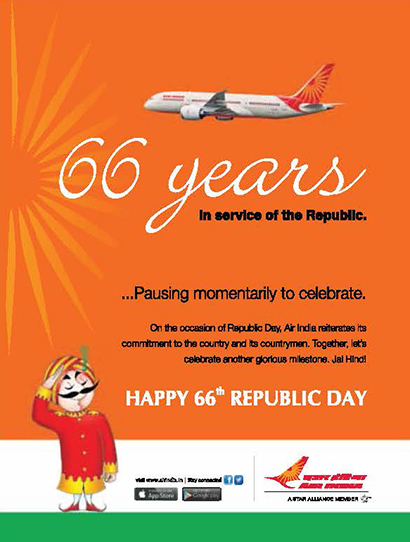 |
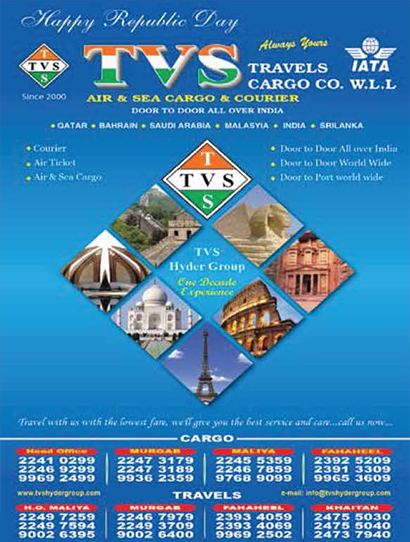 |
Fellow Citizens:
8. Much is said about India's soft power. But the most powerful example of India's soft power, in an international environment where so many countries are sinking into the morass of theocratic violence, lies in our definition of the relationship between faith and polity. We have always reposed our trust in faith-equality where every faith is equal before the law and every culture blends into another to create a positive dynamic. Wisdom of India teaches us: unity is strength, dominance is weakness.
Fellow Citizens:
9. The multi-nation conflict has converted boundaries into bloodlines, and turned terrorism into an industry of evil. Terrorism and violence are seeping across our borders. While peace, non-violence and good neighbourly intentions should remain the fundamentals of our foreign policy, we cannot afford to be complacent about adversaries who will stop at nothing to disrupt our progress towards a prosperous and equitable India. We have the strength, confidence and determination to defeat architects of this war against our people. Repeated violations of the ceasefire along the Line of Control and terrorist attacks must get an integrated response through incisive diplomacy and impregnable security mechanisms. The world must join India in fighting the menace of terrorism.
Fellow Citizens:
10. Economic progress is also a test of democracy. Year 2015 is a year of hope. Key economic indicators provide for much optimism. Strengthening of the external sector, move towards fiscal consolidation, moderation in price levels, early signs of rebound in manufacturing and record agricultural production last year augur well for our economy. Achieving five percent plus growth rates each in the first two quarters of 2014-15 is a healthy sign for an early reversion to the high growth trajectory of 7-8 percent.
11. The success of a society is measured by both survival and strengthening of its values, institutions and instruments of governance. Our national narrative has been shaped by the principles of its past, triumphs of today and is now ready to own the future by powering its latent potential.
Fellow Citizens:
12. Our national ambition is to raise the quality of life of Indians by quantum leaps and raise generations enlightened by learning, patriotism, compassion, honesty and a sense of duty. Thomas Jefferson had said and I quote: “Educate and inform the whole mass of the people... They are the only sure reliance for the preservation of our liberty” (unquote). We must strive for the highest quality in our educational institutions so that we can take our place, within a visible future, among the knowledge leaders of the 21st century. I would urge, in particular, that we lay special stress on the culture of books and reading, which takes knowledge beyond the classroom and frees imagination from stress of the immediate and the utilitarian. We must be a creative people, nourished by innumerable, interlinked rivers of ideas. Our youth must lead the way to mastery of technology and communication in a universe where the cloud has become a library without frontiers, and vast opportunity awaits within the computer in your palm. The 21st century is within India's grasp.
Fellow Citizens:
13. This future will remain both visible and elusive if we do not discover the ability to continually cleanse ourselves of retrograde habits and social ills. Over the past century, some have died, others have faded, but many still exist. We are celebrating, this year, the centenary of Gandhiji's return to India from South Africa. We can never cease to learn from a Mahatma. The first thing he did in 1915 was to keep his eyes open and his lips sealed. It is advisable to follow his example. While we are, rightly, focused on 1915, perhaps we should cast a glance on what Gandhiji did in 1901, the year when he returned home for his first break. The annual Congress session was held that year in Calcutta, then the capital of British India. Gandhiji was a delegate. He went to Ripon College for a meeting. He discovered that the whole place had been dirtied by fellow-delegates. A shocked Gandhiji did not wait for any allotted cleaner. He picked up a broom and cleaned the area. No one followed his example in 1901. 114 years later, let us follow his example, and become worthy children of a magnificent father.
Message of H.E. Mr. Sunil Jain,
Ambassador of India to Kuwait, on the Republic Day of India
Dear Friends, On the occasion of our 66th Republic Day, I convey my warm greetings to each and every member of our community as well as our many, many friends and well-wishers in Kuwait.

On 26 January 1950, the Constitution of modern India came into force. Our Constitution laid the foundation of a democratic and secular State. During these years, the Constitution has witnessed many challenges, however it has remained flexible and vibrant to accommodate various changes which the people of India desired, while remaining steadfast in its fundamentals. Our country has always been committed to the universal peace, harmony, justice and equality, as our civilization is founded on the core value of “Vasudhaiva Kutumbakam”, that is, the world is one family.
The pluralism is an integral part of Indian identity, and it is reflected in every aspect; be it religion, language, ethnicity, political ideology, cuisine, or even geography (deserts, mountains, plains, forests, islands, and coastal areas). We have all the world’s major religions and many spoken languages. A vibrant democracy has been India’s most enduring identity ever since India adopted its constitution that made it a democratic Republic with universal adult suffrage. The 14th General Elections held in April - May 2014, were the biggest elections in the human history, in which 554 million out of 834 million registered voters exercised their franchise, and gave a huge mandate to the new Government under the dynamic leadership of Hon’ble Prime Minister Narendra Modi. In last eight months, the Government has taken various initiatives towards realizing the aspirations of its people by improving the business environment, growth and creation of jobs; and the intensity of India’s international engagement has increased manifold.Today, what excites the world most about India is the Indianeconomy of 1.25 billion people, which is now the 3rd largest in terms of purchasing power parity (PPP) and is showing new dynamism. For its economic transformation, India has addressed both policy and regulatory issues, which have resonated well in the predictions of global rating agencies and major financial institutions. As per the World Bank and OECD, India’s GDP is set to grow by 6.4% in 2015-16. According to the International Monetary Fund (IMF)’s latest world economic outlook, India is said to be worth US$ 2.05 trillion economy in 2014 from US$ 1.88 trillion in 2013, while its GDP size would cross another milestone of US$ 3 trillion in 2019. To improve the ease of doing business in India, the Government is taking multiple steps to simplify procedures, rationalize rules and increased use of technology for efficient and effective governance. Inflation in India has dropped, the currency is stable and the stock market is booming.
The Government has liberalized the Foreign Direct Investment policy. Now, 100% FDI under automatic route has been permitted in construction, operation and maintenance in specified Rail Infrastructure projects; FDI in Defence liberalized from 26% to 49%. In cases of modernization of state-of-art proposals, FDI could be up to 100%; and the norms for FDI in the Construction Development sector are being eased. The Insurance Laws (Amendment) Ordinance 2014, brought by the Government in December 2014, aims to enhance the FDI cap in an Indian insurance company from 26% to 49%.
In recent years, India has made significant progress in linking different parts of the vast country through a more extensive and efficient transport infrastructure. Total length of roads in the country has increased from 0.4 million kilometers in 1951 to over 4.6 million kilometers in 2013. The Government of India is giving utmost importance to the creation of new infrastructure, development of dedicated freight corridors and investment in improving our ports and airports. It plans to build 100 smart cities which will be technology integrated, wellplanned and environ¬ment-friendly. The private sector would be playing a significant role in these developmental works.

M A. ASAD KHAN
(GM-Managing Partner- KSCS,G5 Gen.Trad, & AlLewaa security services)
Look at the flag hoisted as morning sun bathes the day with its mild rays of light. Do you feel excited and enjoy that patriotic feeling that brings in a rush of happiness to realize you are an Indian and you are so blessed to be born as an Indian? Every one must cherish that feeling of being an Indian.
The Indian flag hoisted away in another place apart from our mother land brings in a deeper feeling of excitement and happiness. Can anyone deny that? Once we are away from our motherland, our perception about our country, our people and the lives they live may be different. We get the opportunity to find out where we lag behind and what we need to do to make our mother land a better place to live. As Indian citizens, it becomes our responsibility to share and guide our youngsters who want to be successful and lead our country in the correct path of achievement.
Jai Hind..!
With a large middle class, dynamic and innovative entrepreneurs, plentiful scientific and technical manpower, diversified industrial base and abundant raw materials, India is an attractive business and investment destination. To equip our working population with the requisite skills for the manufacturing sector, a separate Department of Skill Development and Entrepreneurship has been set up. In past 8-months, the Government has launched several programmes, viz. Prime Minister Jan Dhan Yojana (the world’s largest programme of financial inclusion), Swachh Bharat Campaign (Clean India Mission, to modernize sanitation in the country within five years), and Digital India initiative aimed at delivering government services electronically by 2018, which have the potential to transform India.
We are globally among the top 20 exporters of goods and the top 10 services exporters. We are also a leading food producer in the world – the largest producer of milk and the second largest of fruits and vegetables. Owing to its excellent Information Technology and Information Technology-enabled services sectors, India is a software giant and an outsourcing hub, especially for business and knowledge process. Some cutting edge products and services are being developed in India both by multinational companies as well as Indian companies. The government’s policies aim at achieving rapid growth with social justice and equity. There are now over 900 million mobile subscribers in the country. To facilitate the visit of Indian Diaspora to India, the Person of Indian Origin (PIO) and Overseas Citizenship of India (OCI) schemes have been merged, by which PIOs will get life-long Indian visa and exemption from appearing before the local police station on every visit.
India has made remarkable progress in Space Technology and Planetary Exploration. India gave the world the concept of ‘Zero’, has mastered the nuclear cycle, sent expeditions to Antarctica and even unmanned missions to the Moon and Mars. Indian Space Research Organization’s (ISRO) Mars Orbiter Mission ‘Mangalyaan’ was recently named among the best inventions of 2014 by TIME magazine. India also became the first nation to reach Mars orbit in its very first attempt; and joined the elite club of the United States, Russia and Europe. On 18 December 2014, ISRO successfully tested its most powerful satellite launch vehicle - Geosynchronous Satellite Launch Vehicle (GSLV) Mark III. Once operational, GSLV Mark-III will be able to put satellites weighing about 4 tonnes into orbit, almost doubling India’s current capability.
After our Hon’ble Prime Minister Narendra Modi proposed the idea of declaring 21 June as the ‘Int ernational Day of Yoga’ in September 2014, the United Nations General Assembly on 11 December 2014 adopted an India-led Resolution declaring 21 June as the ‘International Day of Yoga’, recognizing that “Yoga provides a holistic approach to health and well-being.” The Resolution received support from 177 countries, the highest number ever for any General Assembly Resolution, including Kuwait joining as a co-sponsor.
On the foreign policy front, India will continue to pursue its enlightened national interest, maintaining the strategic autonomy and independence in decision-making that has been its hallmark. Our overriding priority is to secure an atmosphere of peace and security in which India’s rapid economic transformation can proceed. India will work with other countries to tackle issues of common concern, such as international terrorism, the global economic crisis, climate change, energy security, food security, and the reform of multilateral institutions to reflect contemporary realities. India has consistently been at the forefront of the fight against terrorism and has always unequivocally condemned all forms and manifestations of that evil. Our experience of tackling developmental challenges within a democratic framework, and our emphasis on building convergences and consensus have helped us play a key role in addressing international challenges as well as promoting peace, progress and prosperity globally.

KULDEEP LAMBA
M.D, Almailem group of companies
India with its diversity and culture adds grandeur and richness to the continent where it is located. Our ancient scholars sought knowledge from glittering galaxies that glittered far away. Though the light rays from galaxies took millions of light years to reach us, those ancient scholars could foresee future in minute sketches.
In spite of all their technical knowledge, they also knew the importance of nature and how a better life could evolve from the blessings of nature. Technically we are doing wonders. Yet, it becomes our responsibility to leave a better place for our younger generation to live. Is it not our responsibility to allow our youngsters to have fresh air to breathe and pure water to drink? Unless we help to develop a healthy place to live in, how could they have a safer place to sleep? It becomes the foremost duty of an Indian citizen to think about all these things and be a willing participant to help the administrators to achieve this. Let us pledge at this moment, we all will unite to do so!
JAI HIND!
The Gulf region, as an important part of our extended neighbourhood, is a priority area of our foreign policy. India has vital stakes in the security and stability of the entire Gulf and the Middle East region. GCC is our largest trading bloc, provides about 70% of India’s crude oil requirements and hosts about 7 million Indians. In 2013, India-GCC trade was US$ 153 billion and accounted for over 26% of our global trade.
India’s relations with Kuwait are historically warm, close and friendly. We have been an integral part of each other’s life and consciousness for generations. Our relationship extends beyond historical and cultural linkages to encompass political, trade and economic interests. Kuwait is India’s 3rd largest crude oil supplier. India has consistently been among Kuwait’s top trading partners and the total bilateral trade during the Financial Year 2013-14 was US$ 18.21 billion. In 2014, Indian companies like Dodsal, Shapoorji Pallonji, Larsen & Toubro, Punj Lloyd and Simplex Project Ltd, were awarded EPC contracts in Kuwait worth US$ 4.15 billion in the hydrocarbon and construction sectors. The business communities of the two countries are working in cooperation with one another.
High-level visits and other exchanges between our two countries have helped to further strengthen bilateral relations and explore new avenues of cooperation. His Highness Sheikh Jaber Al-Mubarak Al-Hamad Al-Sabah, Prime Minister of Kuwait visited India in November 2013. During the visit, various Agreements and MOUs were signed. To enhance security cooperation, H.E. Sheikh Thamer Ali Sabah Al-Salem Al-Sabah, President of the National Security Bureau of Kuwait, visited India in February 2014. H.E. Dr. Abdulmohsen Medeij Al-Medeij, Minister of Commerce and Industry led the Kuwaiti delegation to the 4th India-Arab Partnership Conference held in New Delhi on 26-27 November 2014 and as well as Partnership Summit held at Jaipur, Rajasthan on 15-17 January 2015.
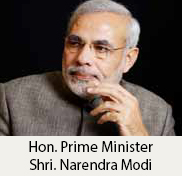 Bilateral Institutional mechanisms like Joint Working Groups on Hydrocarbon; Labour, Employment and Manpower; and the 2nd Foreign Office Consultations between the Foreign Ministries of the two countries were held in Kuwait 2014. Both sides have been working closely to further intensify engagements at all levels. The 3rd Joint Ministerial meeting is scheduled to be held in Kuwait this year. The dynamic Indian community in Kuwait, which is now estimated at over 8 lakh, continues to play its cementing role in strengthening of bilateral ties. It is present in practically all segments of Kuwaiti society and their contribution to the socioeconomic development and prosperity of Kuwait has been highly appreciated. I would like to assure our community of the Embassy’s best possible services for its welfare. I would like to take this opportunity to express my deep gratitude for the benevolence bestowed on the Indian community by His Highness Sheikh Sabah Al Ahmed Al Jaber Al Sabah, the Amir of the State of Kuwait, and for the goodwill of the friendly people of Kuwait. H.E. Mr. Pranab Mukherjee, President of India has extended his warm felicitations to His Highness the Amir of Kuwait on receiving the well-deserved honour of the “Humanitarian Leader” as well as the UN designating Kuwait as the “Global Humanitarian Centre.”
Bilateral Institutional mechanisms like Joint Working Groups on Hydrocarbon; Labour, Employment and Manpower; and the 2nd Foreign Office Consultations between the Foreign Ministries of the two countries were held in Kuwait 2014. Both sides have been working closely to further intensify engagements at all levels. The 3rd Joint Ministerial meeting is scheduled to be held in Kuwait this year. The dynamic Indian community in Kuwait, which is now estimated at over 8 lakh, continues to play its cementing role in strengthening of bilateral ties. It is present in practically all segments of Kuwaiti society and their contribution to the socioeconomic development and prosperity of Kuwait has been highly appreciated. I would like to assure our community of the Embassy’s best possible services for its welfare. I would like to take this opportunity to express my deep gratitude for the benevolence bestowed on the Indian community by His Highness Sheikh Sabah Al Ahmed Al Jaber Al Sabah, the Amir of the State of Kuwait, and for the goodwill of the friendly people of Kuwait. H.E. Mr. Pranab Mukherjee, President of India has extended his warm felicitations to His Highness the Amir of Kuwait on receiving the well-deserved honour of the “Humanitarian Leader” as well as the UN designating Kuwait as the “Global Humanitarian Centre.”

ASHOK KALRA
(Managing Director/Partner) Mughal Mahal & Ex. Hon.Chairman-ICSK)
Have you seen a peacock dance when dark clouds hang on and a cool breeze blows foretelling rain? Those moments are pleasant and make us feel happy! Similarly, whenever we happen to listen to the soothing music from Veena or a Flute, the melody brings in the heavenly bliss.
Our home would be a wonderful place if we wake up to the enchanting call of a koel instead of an alarm from our digital clock. The chattering sparrows and the 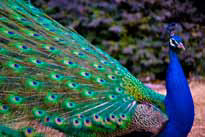 song birds that delight the morning sky have become a dream for most of our children. We have made our children technology savvy and they wake up from their beds by checking messages in their mobile phones.
song birds that delight the morning sky have become a dream for most of our children. We have made our children technology savvy and they wake up from their beds by checking messages in their mobile phones.
With a wish to provide a sophisticated life, we have denied their rights to grow along with the nature. Lack of interaction with the nature has made them lack in compassion and grow selfish and self-centered. As responsible adults, let us give our children the bliss of nature and avail them the opportunity to enjoy the bliss of love from the plant and animal life. Jai Hind..!
The Embassy issued 12,738 visas in 2014 compared to 10,583 visas in 2013, a jump of over 20% in a year.The Embassy has been consistently trying to improve the quality of its services. The Embassy has taken several measures for the welfare of the Indian community in Kuwait. Our community can now reach us on 24x7, in cases of emergency. Upon the demand of our community, the Embassy opened its 3rd outsource center at (Jleeb Al Shuwaikh) Abbasiya, where a significant part of Indian community resides. We are trying to strengthen our Community Welfare Fund so that anyone who is in financial distress can be provided an air ticket to return home, limited medical treatment etc from this Fund. The Embassy has the “Consular Open House” facility where any Indian national can meet a senior consular official without appointment. The Embassy’s “Indian Workers Welfare Center” set up in September 2009 has been providing the much needed support system to our workers with its help desk, labour complaints desk, free accommodation and free legal advice. I would like to take this opportunity to assure that the Embassy will spare no efforts in looking after the issues of concern to our community with maximum sensitivity and care.
On this joyous occasion of our Republic Day, as we rededicate ourselves to serving our people, our motherland and the larger cause of humanity, I wish every Indian in Kuwait good health, happiness and prosperity. I also take this opportunity to convey best wishes from the Indian leaders for the continued good health and well-being of HH the Amir, HH the Crown Prince, HH the Prime Minister, and the friendly people of the State of Kuwait.
Jai Hind!

SIDDHARTHA MUKHERJEE
(Country Manager,Oriental Insurance Kuwait)
Republic Day - A Day of Remembrance… Republic day marks the birth of our nation. It is a great day for all of us. It is a day of remembrance, thanks giving and rejoicing. It is a day to remember and keep alive the fond memories of national heroes who have shed their blood for the freedom of our nation.
It is also a day of national pledge when we decided to make our country, sovereign, democratic, and republic. A great deal more remains to be done, to achieve this pledge. It is up to us to redeem this pledge and make our nation truly democratic and republic.
Happy Republic Day…!
We celebrate the success of India across various fields in the Global arena
- Dr. R. Seetharaman
CEO, Doha Bank Group
On the occasion of the 66th anniversary of Indian Republic Day which falls on 26th January 2015 I extend my warm greetings to all India Citizens. India is one of the oldest civilizations and has a rich and varied heritage. The values that guided our freedom movement, led by Father of the Nation Mahatma Gandhi became the cornerstone of the Independent Indian Republic. The great dream of raising a new India from the ashes of colonialism reached a historic denouement in 1947; 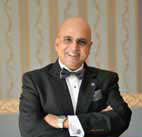 more important, independence became a turning point for an equally dramatic narrative, nationbuilding. The foundations were laid through our Constitution, adopted on 26 January 1950, which we celebrate each year as Republic Day. Its driving principle was a compact between state and citizen, a powerful public-private partnership nourished by justice, liberty and equality. India’s Constitution represented a liberation from the stranglehold of traditional inequity in gender, caste, community that had c hained us for too long. This inspired a Cultural Evolution which put Indian society on the track to modernity: society changed in a gradual evolution. In last six and half decades our economic growth rate has more than tripled and our literacy rate has increased by over four times. India has also secured a respected place in the comity of nations. India is the largest democracy and is committed to tolerance, harmony, equality, justice, and the rule of law. India today is poised for a giant leap from the ranks of developing countries to developed countries. India’s GDP grew at an average of 7.6 percent between 2004-05 and 2013-14, second only to China and far higher than the US and European countries. Our economic activity is projected to pick up gradually on account of various measures taken by the current government.
more important, independence became a turning point for an equally dramatic narrative, nationbuilding. The foundations were laid through our Constitution, adopted on 26 January 1950, which we celebrate each year as Republic Day. Its driving principle was a compact between state and citizen, a powerful public-private partnership nourished by justice, liberty and equality. India’s Constitution represented a liberation from the stranglehold of traditional inequity in gender, caste, community that had c hained us for too long. This inspired a Cultural Evolution which put Indian society on the track to modernity: society changed in a gradual evolution. In last six and half decades our economic growth rate has more than tripled and our literacy rate has increased by over four times. India has also secured a respected place in the comity of nations. India is the largest democracy and is committed to tolerance, harmony, equality, justice, and the rule of law. India today is poised for a giant leap from the ranks of developing countries to developed countries. India’s GDP grew at an average of 7.6 percent between 2004-05 and 2013-14, second only to China and far higher than the US and European countries. Our economic activity is projected to pick up gradually on account of various measures taken by the current government.
India is land of unity in diversity. It has different languages, customs, art and culture. Indian dance has themes drawn from mythology, legends and classical literature. Indian literature can date its origins to the oral tradition of the Vedas and the great epics of India, which are still an integral part of daily life.
Indians have a diverse selection of cuisine types. India’s Bollywood, Kollywood, tollywood and other regional language films have attracted global audiences.

Indians have spread across globally on account of their knowledge, skill and commitment. On account of this Indian culture has also transcended borders in the form of dance, literature, food, music, festival or cinema Indian festivals are celebrated gl obally. The Indian Culture has brought Global Indian Community closer.
obally. The Indian Culture has brought Global Indian Community closer.
GCC- India Bilateral trade is over $150bn for 2013-14 and there is significant potential on bilateral trade, finance and investment between the both blocs. GCC is home to a large Indian expatriate population, which constantly nurtures and renews the ties of friendship and understanding between the two blocks. The dynamic and lively Indian community in GCC continues to play its part in the rapid evolution and up gradation of ties.
As we live in an interconnected world Indian nationals have also come under the umbrella of global citizenship. Indians will play an active role on social responsibility, global awareness and civic management. We need social solidarity and hence Indians will become Global Citizens to accomplish this. The goals of liberty, equality and the pursuit of happiness can bring together people from all over the world, which is why it’s important to be a Global Citizen.
On this day we take pride as an Indian and celebrate the success of India across various fields in the Global arena and once again I extend my Republic day greetings to all Indian Citizens.
Jai Hind

CHEJARLA INDRA KUMAR RAJU
Chairman,Burgan Express Gen.Trd.Cont.Co,
Sun victoru Int.Ltd ,Hong Kong
I wish to reproduce the words of Dr. Rajendra Prasad, the first President of Independent India, in his special message to his countrymen, on the birth of the Indian Republic:
“We must re-dedicate ourselves on this day to the peaceful but sure realization of the dream that had inspired the Father of our Nation and the other captains and soldiers of our freedom struggle, the dream of establishing a classless, co-operative, free and happy society in ‘his country’. We must remember that this is more a day of dedications than of rejoicing - dedication to the glorious task of making the peasants and workers the toilers and the thinkers fully free, happy and cultured.”
Jai Hind..!
India’s brain power has been spreading across the world
- M. Shayinsha Khan Managing Director, (NQG)
Watching the Republic Day parade has been my favorite watch every year on January 26th. 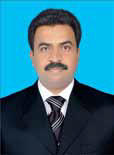 The hoisting of our Indian flag and the heart stirring National Anthem always brought tears and I could feel my nerves tingle and goose bumps run through my body. That is a wonderful feeling that makes me feel awesome and feel proud once again “I am a born Indian”. The three colors of our flag, saffron, white and green reminds me of the valuable lessons life has taught me as an Indian. Saffron always reminds me of the saffron colored dress worn by our ancient gurus who preached non-violence and peace. Our ancient land had seen scholarly souls who always adorned saffron dress and stood as icons for knowledge and visions for a better life forever.
The hoisting of our Indian flag and the heart stirring National Anthem always brought tears and I could feel my nerves tingle and goose bumps run through my body. That is a wonderful feeling that makes me feel awesome and feel proud once again “I am a born Indian”. The three colors of our flag, saffron, white and green reminds me of the valuable lessons life has taught me as an Indian. Saffron always reminds me of the saffron colored dress worn by our ancient gurus who preached non-violence and peace. Our ancient land had seen scholarly souls who always adorned saffron dress and stood as icons for knowledge and visions for a better life forever.
 The white color reminds me of the peace that everyone across the world. When I read through the Indian history when our ancient kings fought in the battlefield, they always remembered the significance of white color. The green color reminds me of the rich wealth and natural wonders that our country adorns. The green color rings in a positive note that reminds again and again that nature is our best friend and it is our duty to maintain a better world for the future generation to live here.
The white color reminds me of the peace that everyone across the world. When I read through the Indian history when our ancient kings fought in the battlefield, they always remembered the significance of white color. The green color reminds me of the rich wealth and natural wonders that our country adorns. The green color rings in a positive note that reminds again and again that nature is our best friend and it is our duty to maintain a better world for the future generation to live here.
India has been growing successfully in the field of technology that makes our lives easy and sophisticated. Yet, we should not forget one thing. Apart from all the comfort that technology has provided, the most important thing we need to teach our youngsters is to have the feeling of compassion. Learn to respect others; learn to respect your elders; learn to give space for others and refrain from being very selfish. India’s brain power has been spread across the world. Yet, the people here in India who are not fortunate still struggle to have a decent livelihood. Cleanliness, following a healthy diet and the willingness to learn and relearn are the only factors that would make our lives a healthy and wealthy one and Happy Republic Day.
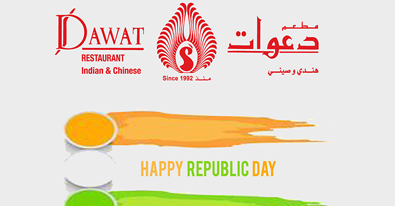 |
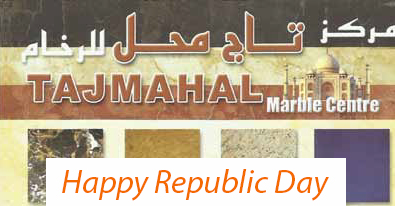 |
NITI AAYOG
R. Chinnaiyan, Deputy General Manager, Kuwait India International Exchange Co
“We can’t solve problems by using the same kind of thinking we used when we created them”. - Albert Einstein
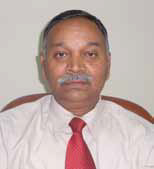
Introduction: The year 2015 dawned in India with the announcement of the establishment of National Institution for Transforming India (NITI) Aayog as a successor to and in replacement of the Planning Commission. NITI Aayog will be responsible for formulating a “Bharatiya approach to development”. The new Institution is seen as a think tank that will foster “cooperative federalism” rather than take a top-down approach. This is an important evolutionary change from the past replacing a “Centre – to – State, one – way flow of policy by a genuine and continuing partnership with the States”. It will serve as a think tank for the central as well as the state governments.
Planning Commission:
We shall briefly deal with the predecessor of NITI Aayog, the Planning Commission. The Planning Commission was set up by a resolution of the Government of India in March, 1950 in pursuance of declared objectives of the Government to promote a rapid rise in the standards of living of the people by efficient exploitation of the resources of the country, increasing production and offering opportunities to all for employment in the service of the community.
 The Planning Commission was charged with the responsibility of making assessment of all resources of the country, augmenting deficient resources, formulating plans for the most effective and balanced utilization of resources and determining priorities.
The Planning Commission was charged with the responsibility of making assessment of all resources of the country, augmenting deficient resources, formulating plans for the most effective and balanced utilization of resources and determining priorities.
Jawharlal Nehru was the first Chairman of the Planning Commission. The main thrust of the Planning Commission was formulation of Five Year Plans and to play a mediatory and facilitating role in the matter of allocation of resources, keeping in view the best interests of the centre – various ministries and the states.
It was aimed to help creating a culture of high productivity and efficiency in the Government. In all, in its existence of 65 years, the Planning Commission formulated 12 Five Year Plans – starting with the first Five Year Plan 1951-56 to the twelfth Five Year Plan 2012-2017 (Annual Plans formulated between 1966 and 1969, 1990-1991, 1991-1992). The Commission was overseeing and approving the annual budgetary plans of the State Governments. The emphasis was on a growing public sector with massive investments in basic and heavy industries up to the first eight plans and thereafter the emphasis on public sector became less pronounced.
The Planning Commission went through a number of operational changes over the years ranging from being a simple planning body to a powerful “control commission” to a fiscal decentralization instrument to an official think tank – voices had begun to grow louder for an overhaul.
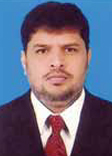
S.M.HYDER ALI
Chairman, TVS Travels & Cargo services co. Wll..
On this day I recollect our President, Shri Pranab Mukherjee”s , address to the Nation on the eve of last year 65th Republic Day.
The Republic Day commands the respect of every Indian.. We undertook to promote among all citizens fraternity, the dignity of the individual and the unity of the nation. These ideals became the lodestar of the modern Indian State.
Democracy became our most precious guide towards peace and regeneration from the swamp of poverty created by centuries of colonial rule. From within the spacious provisions of our Constitution, India has grown into a beautiful, vibrant, and sometimes noisy democracy. For us, the democracy is not a gift, but the fundamental right of every citizen.
Happy Republic day!
India’s ranking in 2014: Index of Economic Freedom : 120 (out of 186 countries) (Heritage Foundation, USA) Corruption Perception Index : 85 (out of 175 countries). (Transparency International, Germany) Mr. Shenoy appointed to the Panel of Economists who were to appraise Nehru’s ambitious Second Five-Year Plan gave a bold and courageous dissenting note: “I do not feel convinced of the economic importance of continuing the remnants of controls. Decontrols have proved a noteworthy success.

RAVI VARRIER
Al Rashed Shipping
We are proud ..!
The Republic Day celebrations have rightly become world famous as one of the greatest shows on earth drawing thousands of eager sightseers from all over the country and many parts of the world. No other country can draw on such a wealth of tribal traditions and cultures, so many regional forms of dances and dress.
And, no other country in the world can parade so many ethnically different people in splendid uniforms as India’s Armed Forces. But they are all united in their proven loyalty to the Government elected by the people and in their proud traditions and legendary gallantry.
Happy Republic day!
Controls and physical allocations are not a necessary adjunct to planning. I am unable to agree with my colleagues that a case exists for continuing what controls now remain. Steps should be taken to remove controls as early as may be possible. Controls and allocations are an essential characteristic of communist planning. They do not very well fit in, under planning in a free enterprise market economy ---the only hope of eradication of corruption on the current scale is a complete U-turn in our policies”. However, what actually happened is too well known to be recounted here.
The Structure of NITI Aayog:
This body will be headed by the Prime Minister and would comprise a vice-chairperson, besides full time and part-time members. The Aayog will have up to four members of the council of ministers and a chief executive officer of secretary rank. Dr. Arvind Panagariya a noted Indian American economist was appointed as the first vice chairman of the NITI Aayog. The vice chairman will be assisted by two full time members – Mr. Bibek Debroy, economist and Mr. V. K. Saraswat, former Defence Research and Development Organisation Chief. There will be three special invitees. A Governing Council is proposed which would comprise all the Chief Ministers and Lieutenant Governors of Union Territories. Regional Councils would be formed based on need.
NITI Aayog will seek to provide critical directional and strategic input into the development process to create a greater stake for states in development. The Aayog will provide a national agenda for the primate minister and chief ministers while recognizing that “strong states make a strong nation”. It will also interact with other national and international think tanks, as also with educational and policy research institutions. Getting the chief ministers involved in formulating the country’s development vision was the right way to go. The intention to create the Aayog where states’ leaders will be part and parcel of collective thinking with the centre and other stakeholders in formulating a vision for the development of the country is the best of planning and implementation as compared with the previous structure, where a handful of people formulated the vision and presented it to the National Development Council (NDC).
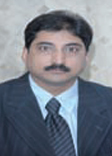
DR. BHASKAR GUPTA
|
|
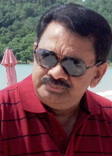
AN.NATARAJAN
Hotel Saravanaa Bhavan, kuwait
Great Republic !
31 States
1618 Languages
6400 castes
6 Religions
6 Ethnic Groups
29 Major Festivals , but ,
1 country !
With Freedom in Mind
Faith in words
memories in souls
Be proud to be an Indian
Great Republic !
Happy republic Day !
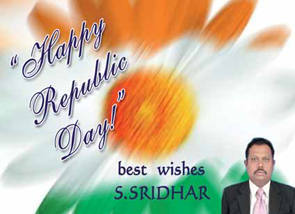
In conclusion, we can say that with the creation of this new body, wherein the federal structure is well respected and represented, it is hoped that the development would receive the much needed fillip. The most important aspect in this initiative is to bring the states on board and instill a participatory feeling. Only when the states are strong can the entire country be strong. To achieve this goal, it is very much essential that the states fully involve in this and take ownership of the role they would be required to play. It is to be seen whether the new avatar would remove the weakness seen in the earlier body. Or is it the old wine in a new bottle? The Jury is still out.
It is apt to quote Thiruvalluvar a great sage-poet who wrote Thirukkural in Tamil on almost all subjects with everlasting values.
In the Kural, (couplet) quoted below he says that nothing is impossible when an initiative is taken at the proper time to suit the changing times by employing suitable tools/strategies.
(Aruvinai enba ulavo karuviyar - Kalamarindhu cheyin)
 |
 |
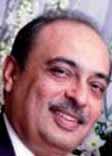
RAVI KOHLI
|

AZIZ F
|
Indian Achiever
Manju Shahul-Hameed- Mayor of London Borough Croydon in South London
When she left for Britain to join her husband Raffi in 1996, little did Manju Shahul- Hameed, a native of Thiruvananthapuram, dream of becoming anything more than a homemaker over there. 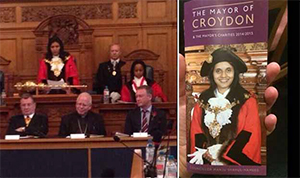 Today, she is the Mayor of London Borough Croydon in South London.
Today, she is the Mayor of London Borough Croydon in South London.
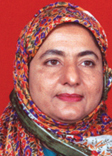
Dr. Saleha Mossa
Al Moosa Group
As a Mayor, she seeks to “celebrate the diversity and culture of Croydon and make it a great place to raise a family.” She also supports two charities — Age UK and Macmillan Cancer Support as part of her Mayoral duties.
Talking about her plans to open a charity to encourage home makers to volunteer, she said the spirit of volunteering in business and community organisations, needed to pick up in Kerala which was a great way of gaining experience. On how she overcame the language barrier, she said all that one needed to make a positive change was to have faith in one self.”
|
N.S.SHETTY
|
With Great Enthusiasm and Joy
|
DELHI BATCHA
|
Every Indian must strive hard to tackle the challenges
Look at the hoisted flag that flies high with its vibrant three colors. For me it reminds the path we have walked through all through these years after the Indian constitution came into force. After getting the independence to be on our own, the acceptance for our own constitution marked the beginning of our walk towards growth and emerges as a powerful nation in the whole world.
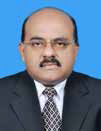
ARIF MARICAR
Project Document Controller,
MEW
Technically, scientifically and ethically, we Indians must strive hard to be on the mark of the world map. Though there is no dearth in the success of Indian brains all over the world, the common man in India still struggles to make the two ends meet and provide their children nutritious meals, quality education and a healthy place to live in. Technology has grown to a large extent in India. The penetration of mobile phones in the lives of the common man will definitely tell how we have accepted technology into our lives.
Though we are now used to live a life with comforts, still challenges remain unresolved. With the growing population, the expectations are also growing in umpteen numbers. Every Indian must strive hard to tackle the challenges at all levels and help the country to progress forward in a healthy way. Compared to the situation decades ago, the Indian population now has the awareness to fight for its rights and get their problems solved.
The world has been quite competitive and it has become our responsibility to meet the international standards that would allow us to be successful globally. Society at large has been changing for a while. The lives the youngsters lead today are much different from the lives of the people who lived during our pre-independence days. The space needed for growth must be always there. Let us be supportive and help our younger generation to move forward and be successful and happy Republic day to all.

S. JAISHANKAR
Vice President – Operations, Al Ghannam Tires Center Co WLL.,
On this 66th Republic day, I wish India must find its own solutions to its problems. We must be open to all knowledge; But we should not indulge in the easy option of mindless imitation, for that can lead us to a garden of weeds. India has the intellectual prowess, the human resource and financial capital to shape a glorious future.
We possess a dynamic civil society with an innovative mindset. Our people, whether in villages or cities, share a vibrant, unique consciousness and culture. Our finest assets are human.
Happy Republic day!
 |
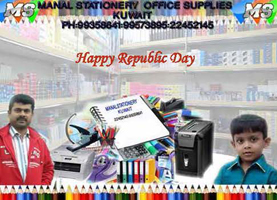 |
 |

BALASUBRAMANIAN VALAVAN
Vice president ( overseas operation) EDAC Engineering ltd.
On this republic day lets make a stand and be honest towards our country. A great salute to all the soldiers serving in Army, Air Force, Navy, BSF, CRPF and rest of the military forces. Thanks for guarding our boundaries from inside and outside.
On this day think of our past and try to build better future for all of us. It is a duty of all of us!! I am proud to be an Indian.
Happy Republic Day !!!
Kerala Varma Pazhassi Raja
-Sunil Menon
Al Qabandi United Company, Kuwait
 Kerala Varma Pazhassi Raja (also known as Cotiote Rajah or Pychy Rajah) (3 January 1753 – 30 November 1805) was one of the earliest freedom fighters in India. He was the prince regent of the princely state of Kottayam or Cotiote in Malabar, India between 1774 and 1805. His struggles with English East India Company is known as The Cotiote War. He is popularly known as Kerala Simham (Lion of Kerala) on account of his martial exploits.
Kerala Varma Pazhassi Raja (also known as Cotiote Rajah or Pychy Rajah) (3 January 1753 – 30 November 1805) was one of the earliest freedom fighters in India. He was the prince regent of the princely state of Kottayam or Cotiote in Malabar, India between 1774 and 1805. His struggles with English East India Company is known as The Cotiote War. He is popularly known as Kerala Simham (Lion of Kerala) on account of his martial exploits.
Pazhassi Raja was a member of the western branch of the Kottayam royal clan. When Hyder Ali of the Kingdom of Mysore occupied Malabar in 1773 the Raja of Kottayam found political asylum in Travancore. Pazhassi Raja, the fourth prince in line for succession to the throne during this period, became one of the de facto heads of state surpassing several of his elder royals. He fought a war of resistance on Mysorean army from 1774 to 1793. On account of his refusal to flee and resolve to fight invaders, people of Kottayam stood firmly behind the Raja who had not abandoned them in their hour of misfortune.
In 1792, after the Third Anglo-Mysore War, English imposed their paramountcy in Kottayam in violation to their earlier agreement of 1790 which recognised independence of Kottayam.Vira Varma, to whom Raja was a nephew, was appointed by the East India Company authorities as the Raja of Kottayam.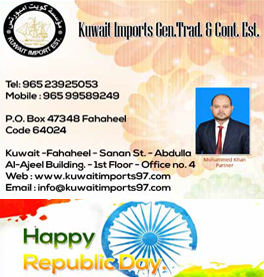
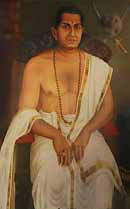
To meet revenue target fixed by Company authorities, Vira Varma ordered exorbitant rate of tax to be collected from the peasantry and this move was met by a mass resistance led by Pazhassi Raja in 1793 who was opposed to surrender to English right from beginning. In 1796, the Company made an attempt to arrest Pazhassi Raja, but he evaded capture and instead fought back using guerrilla warfare.
After a string of serious setbacks, the Company sued for peace in 1797. The conflict was renewed in 1800 over a dispute on Wayanad and after an insurgent warfare lasted for five years, Pazhassi Raja was killed on 30 November 1805 in a gunfight at Mavila Todu near Kerala-Karnataka border.
Pazhassi Raja resisted British imperialism from 1793 onwards till his death in 1805. He fought two wars to resist British intervention in the domestic affairs of his kingdom. From 1793–1797 he fought over the question of the management of Kottayam and from 1800–1805 over the issue of who was to be master of Wynad. British called their wars with Pazhassi Rajah as Cotiote War.
On 1805, 30 November, Raja and retainers were camped near close to Karnataka on shore of a stream named Mavila or Mavila Tod [not far from Pulpally].
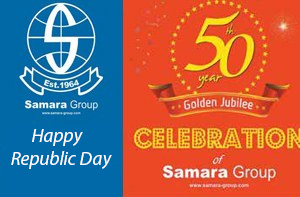 Raja and party were caught by surprise and an intense but short fight followed. Six rebels were killed. One of the earliest rebels to be killed was Pazhassi Raja The precise nature of Raja›s death is controversial. Folklore insists that he committed suicide by swallowing a diamond ring to avoid capture after he was wounded.
Raja and party were caught by surprise and an intense but short fight followed. Six rebels were killed. One of the earliest rebels to be killed was Pazhassi Raja The precise nature of Raja›s death is controversial. Folklore insists that he committed suicide by swallowing a diamond ring to avoid capture after he was wounded.
T. H. Baber›s version was that it was a clerk named Canara Menon who killed Raja. W. J. Wilson, who wrote on the history of the Madras Regiment, credits Captain Clafam and his six sepoys for killing of Raja.This third version of Raja’s end is more likely as Baber was not on good terms with military authority throughout the Pazhassi War. He is alleged to have credited Menon so as to deny credit to Clafam and his superior Colonel Hill.
In his decades long war to oust invaders, Rajah developed an elaborate system of cantonments and forts in jungly and mountainous part of his country.
Four of them are most important – granite fort on Purali range [modern Muzhakunnu] which was built by his ancestor Harischandra Perumal over a thousand years ago. He had another granite fort at Manatana. In Wynad, he had a great fort in Mananthavady which was reported to have ability to house his whole army of 6000 men. He also had a stronghold in Todikulam near Kannavam which belonged to his supporter Kannavath Sankaran.
Of all his strongholds, none survive today. Only ruins of Purali fort survive today. It is today a heap of granite boulders. Only a tank still survives today. A nearby black-stone cave where Raja once lived can still be found.
REPUBLIC DAY - ARE WE IN THE RIGHT DIRECTION ?
- Kanchi Gupta,Student Std XII
With progressive thinkers like B.R Ambedkar, Pandit Govind Ballabh Pant, Alladi Krishnaswamy Iyer, B L Mitter, Md. Saadullah and Sir Narsing Rau we have been privileged to appreciate 26th January as our Republic day 20 years before it was adopted.
Every year we celebrate this day with a grand parade is held in the capital, New Delhi, from the Raisina Hill along the Rajpath, past India Gate which showcases Indians Defense Capability, Cultural and Social Heritage.
This is a day when we take pride in our achievements, but it must s
urely also be a day of honest self-analysis and selfquestioning about where we, as a people and a society, are headed.
Sixty five years into our life in the Republic we find that Justice - social, economic and political - remains an unrealized dream for millions of our fellow citizens. The benefits of our economic growth are yet to reach them. We have one of the world’s largest reservoirs of technical personnel, but also the world’s largest number of illiterates; the world’s largest middle class, but also the largest number of people below the poverty line, and the largest number of children suffering from malnutrition.
Our giant factories rise from out of squalor; our satellites shoot up from the midst of the hovels of the poor. Thanks to our early and visionary support to science and technology we have made advances in that field as would excite human imagination anywhere. We can be justly proud of the abundance of our entrepreneurial ability, the high levels of domestic private savings, and also of the high level of managerial and technical skills. All these have enabled our economic reforms to have a solid and a stable base for further and more rapid growth. A country with a population of more than 1.2billion and rising India has transformed more in the past 6 years than the past 6 decades leading to the rise of the query what do we mean by republic? A formal defination states that a republic is a state in which supreme power is held by the people and their elected representatives and here is where the question of the hour rises. IS INDIA TRULY HELD BY THE NATIONALS OF THIS MAGNIFICIENT SUBCONTINENT OF CULTURES OR BY THE POWER HUNGRY MINORITY ?


We reside in a country stricken with poverty, terrorism, abuse towards women and children, corruption, sanitation, religious violence and many more issues which we easily regard unseen as they aren’t tangible directly towards us.
As Mr.Shashi Tharoor states “India is not, as people keep calling it, an underdeveloped country, but rather, in the context of its history and cultural heritage and potential, a highly developed one in an advanced state of decay.”
But with leaders like Narendra Modi and exemplary personalities like A.P.J Abdul Kalam,Kailash Satyarthi, Arnab Goswami, Irom Sharmila etc. we can still pave our way from this state of disintegration by working together towards change! We can accept these charismatic individuals as our role models and walk on their footsteps of self scarification and team work towards a non selfish goal . As Muhammad Ali Jinnah quotes “India is not a nation, nor a country. It is a subcontinent of nation. The world watches us with a combination of admiration and concern: admiration at what we have achieved despite great odds, and concern over the fact that, even with great investments of money and energy we remain far from our goal. Indians do well, they say; India does not.
Only when these different cultures come together can we free our nation from its dirt and form a true meaning to the celebration of our republic day.
Jai Hind
NRI’s Role In Economic Development Of India
In the age of economy slowdown, India is passing through a bad phase and its monetary condition is severely affected. Inflation rate is high and people are unable to manage their daily life. In this context Indian go
 vernment has great expectations from millions of Non-resident Indians to resolve the crisis through making investments in India.
vernment has great expectations from millions of Non-resident Indians to resolve the crisis through making investments in India.
NRIs generate earnings is estimated to be $250 billion and is one third of the GDP of India. This clearly indicates that they can contribute a lot to Indian economy and enhance its fiscal growth.
With the net worth of the NRI baby boomer generation increasing, marvellous opportunities are provided for them by the government. This actually had begun since the year 2000, when a high level Indian Diaspora committee headed by Dr. L.M. Singhvi, was established to tap the NRIs resources and to discover the possibilities of their investments in India. Since then India is reaching out more NRIs for their attention to support in the India’s developmental activities. There are numerous opportunities provided by the government to the NRIs to invest in India.
The Reserve Bank of India has directed the Indian banks to attract NRI deposits and there are numerous short and long term investment plan option for them.  Besides, NRIs are encouraged to establish business and educational institution in India. As a result of all this there is greater involvement of NRIs in India. Even though NRI’s contribution is not visible but they are helping their country through varied activities in India. Many reports reveal that NRI’s are major source of Direct Foreign Investment, market development (outsourcing), technology transfer, charity, tourism, political contributions and more substantial flows of knowledge, in India.
Besides, NRIs are encouraged to establish business and educational institution in India. As a result of all this there is greater involvement of NRIs in India. Even though NRI’s contribution is not visible but they are helping their country through varied activities in India. Many reports reveal that NRI’s are major source of Direct Foreign Investment, market development (outsourcing), technology transfer, charity, tourism, political contributions and more substantial flows of knowledge, in India.
The NRIs have came forward with several non-governmental organizations in India helping in array of developmental, educational and social projects.
It has been observed that large number of NRIs is actively taking part in several welfare programs in India. They have registered many NGOs to encourage education, health care and developmental activities such as water management, rural development and self-help programs etc.
Indo-Caribbeans, Indo-Fijians and other communities have contributed a lot in social service in India. Many of them have come forward to support their schools and colleges where they studied in India. Some have also launched schools and colleges in their ancestral villages and towns. They are also assisting in social and environmental problems in India.
Good news is there are many NRI’s who are returning to India and most of them are highly qualified and experienced persons. If their professional knowledge and monetary resources are joined together, it will be beneficial for the country’s development. Professor Amartya Sen, Noble prize winner in economic is one such NRI, who is contributing his knowledge for the development of India. NRIs can play significant role in shaping India’s monetary, social and economic conditions.
Indian government should encourage them for making investments and involve them in other developmental activities in India. NRIs contributions in the development of India.NRIs can play significant role in shaping India’s monetary, social and economic conditions. Indian government should encourage them for making investments and involve them in other developmental activities in India. NRIs contributions in the development of India cannot be ignored.
The Majestic Lions
Kalai Selvi Arivalagan, Senior Content Writer
Lumina Datamatics,Chennai
The majestic lions, the chakra and the inverted lotus on the pedestal remind me once again of the life everyone deserves to live.
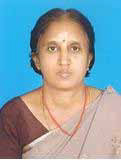 The scenario at the world keeps changing every day. Unexpected challenges shoot up every second for the future generation. As responsible adults what role should we play to make our planet a safer place for them? Every one has the responsibility to answer this million dollar question. Today, the younger minds are chasing materialistic wealth that can perish at any unexpected moment. Who is going to tell them that they need to look into their inner hearts and question if they have been a good human being at least for a while? Who is going to boost the morale of the youth and lead them in the correct path? India has been a place with abundance of wealth that made both our mortal and immortal lives enriched at all levels. Let us today take the oath to help them realize it and be a better human being.
The scenario at the world keeps changing every day. Unexpected challenges shoot up every second for the future generation. As responsible adults what role should we play to make our planet a safer place for them? Every one has the responsibility to answer this million dollar question. Today, the younger minds are chasing materialistic wealth that can perish at any unexpected moment. Who is going to tell them that they need to look into their inner hearts and question if they have been a good human being at least for a while? Who is going to boost the morale of the youth and lead them in the correct path? India has been a place with abundance of wealth that made both our mortal and immortal lives enriched at all levels. Let us today take the oath to help them realize it and be a better human being.
 I think it is apt to quote Rabindranath Tagore’s famous lines: Where the mind is without fear and the head is held high Where knowledge is free Where the world has not been broken up into fragments By narrow domestic walls Where words come out from the depth of truth Where tireless striving stretches its arms towards perfection Where the clear stream of reason has not lost its way Into the dreary desert sand of dead habit Where the mind is led forward by thee Into ever-widening thought and action Into that heaven of freedom, my Father, let my country awake.
I think it is apt to quote Rabindranath Tagore’s famous lines: Where the mind is without fear and the head is held high Where knowledge is free Where the world has not been broken up into fragments By narrow domestic walls Where words come out from the depth of truth Where tireless striving stretches its arms towards perfection Where the clear stream of reason has not lost its way Into the dreary desert sand of dead habit Where the mind is led forward by thee Into ever-widening thought and action Into that heaven of freedom, my Father, let my country awake.
 Opening of shelter for female expatirate workers The Public Authority for Manpower, Kuwait has opened a shelter for expatriate female workers in Jleeb Al-Shuwaikh (Abbasiya) from 23 December 2014. The Embassy has transferred its distressed 64 Indian female domestic workers to the Kuwaiti Government shelter with effect from 6 January 2015. The Kuwait Government shelter will provide free of cost board and lodging and limited medical attention.
Opening of shelter for female expatirate workers The Public Authority for Manpower, Kuwait has opened a shelter for expatriate female workers in Jleeb Al-Shuwaikh (Abbasiya) from 23 December 2014. The Embassy has transferred its distressed 64 Indian female domestic workers to the Kuwaiti Government shelter with effect from 6 January 2015. The Kuwait Government shelter will provide free of cost board and lodging and limited medical attention.
The address of the Kuwaiti Government Shelter is as below:

Kuwait Shelter for expatriates Block No. 2, Police Station Street Near Nimran Pharmacy Jleeb Al-Shuwaikh (Abbasiya) (Contact person: Mr. Abu Turki-Supervisor) Any distressed Indian female domestic worker who is in need of accommodation in Kuwaiti Government shelter, can contact the Embassy of India in Kuwait on a working day before 12.00 hrs for her transfer to the above Shelter, after completion of formalities at the Embassy. As per the regulations of the Kuwait Government shelter, they will not accept any pregnant female domestic worker.
Contact numbers of Embassy officials are as follows:
i. Telugu speaking : Ms. Thriveni Reddy 97108538
ii. Tamil speaking : Mr. Hamza 66586006
iii. Malayalam speaking : Mr. Sudheendran 99183576
iv. Bangla speaking : Mr. S. Goldar 97229942
v. Hindi speaking : Mr. Ashok Kumar 97229946
 As an NRI, We Can Help India Grow In
As an NRI, We Can Help India Grow In
These 6 Ways
Listed below are some of the ways by which NRIs can contribute to the growth and prosperity of India.
6. Paying Proper Income Tax
It’s high time we know and understand that the NRI status is given by the Indian Government only to facilitate adjusting the tax-paying status of a person. In other words, it’s a status provided by the Income Tax Department, and you do have to pay taxes in India even if you’re not staying in Indian Territory. So, NRI or not, your liability towards the country doesn’t change but only remodels itself, to put it bluntly. Hence, by paying proper Income Tax, any NRI can help the country to prosper and grow substantially.
5. Make Donations to the Indian NGOs
One of the primary ways an NRI can help India is by donating amounts regularly to some established NGOs working for the benefits of the women or children or against the social ills that our country is steeped into. By doing this, you also get to know about the current situation of your country and hence, help it to prosper in the right direction, in the right manner. Nowadays, with the internet and e-banking facilities available, making online donations and supporting NGOs miles apart were never easier!
4. Spread Knowledge
The best way we think any NRI can contribute towards the growth of India is by spreading his knowledge about the different aspects of life and social changes that he or she has witnessed during the stay at some other country among his kith and kins. By writing articles across the print and electronic media comparing the goods and evils of those countries to that of India and by putting in the right amount of effort, one can bring about great changes in the societies, thereby making India a better place to live in.
3. Adopt an Indian Child or Sponsor Some
Adopting children may not be much prevalent in our country, but it’s surely much prevalent in the western countries. And, what better way can any NRI help India but by adopting Indian children and thereby, playing a definitive role in irradiating poverty and other abuses against children. Many NRIs have done it, and many more can surely do so, and hence, bring about a real social change in India.
2. Develop Business Start-ups or Invest in Indian Companies
If possible, after gaining much experience at some MNC abroad, an NRI can open up his own business enterprise in India. By doing so, he can not only start up something worthwhile on his own but also help India grow in a positive way by generating more employment opportunities! If this isn’t possible, then he or she can invest, instead of in any foreign companies, in MNCs based in India—thereby facilitating the growth of India along with guaranteeing his own prosperity.
1. Research and Development of Effective Measures to Curb Social Paralysis
Even if you’re staying abroad, you can help India to fight all its social evils by developing models and innovative ways to remodel and educating the society. To this extent, you can even pressurize the Government to adjust and make few amendments; after all, you too generate a substantial amount of income for the Indian Government and are a regular payer of taxes. You can work up on a number of areas, depending upon your interest—agriculture, education, sports, counterterrorism actions, activism against social ills, etc—and bring about a great change in India!
Indian Embassy – Kuwait Services
Outreach to Indian nationals:
To assist Indian national in Kuwait, the Embassy opened a Passport Centre in Jleeb Al Shuwaikh (Abbasiya) from August 2014. Further, the visa procedure was streamlined and simplified for the benefit of Kuwaiti and other foreigners travelling to India. Also, to render assistance with regard to passport, visa and attestation services, an ‘open house’ is being held every working day, once in the morning from 1000-1100 hrs and again in the afternoon from 1430-1530 hrs.
a) “Open House” by Ambassador on every Wednesday from 1500-1600 hrs. During this “Open House”, any member of the Indian community can interact with Ambassador without prior appointment.
b) Mobile numbers of all officers are given on the Embassy’s website. All Indian nationals may use this facility to call the concerned officer as per the need.
c) An emergency contact number 22530600 is available on 24/7 basis for all Indian community members residing in Kuwait.
Comments, suggestions etc. from Indian community in Kuwait are most welcome to further improve the Embassy services.
Indian Community Welfare Fund (ICWF) For the welfare of Indian Community present in Kuwait, the Government of India has been providing financial assistance to distressed Indian nationals. The Embassy has been providing monetary help from the ICWF in following circumstances:
i) Boarding and lodging for distressed Indian Workers in domestic sectors (Article 20 visa);
ii) Extending emergency medical care to the Overseas Indians;
iii) Providing air passage to stranded and distressed Overseas Indians; and
iv) Expenditure on incidentals and for airlifting the mortal remains to India of the deceased Overseas Indians in cases where sponsors are unable or unwilling to do so as per the contracts and the families are also unable to meet the cost. The number of cases during the year 2014 in which Embassy provided air ticket, medical care and contingency travel expenses to the distressed Indian Workers are as under:- (During the Year 2014)
|
Destitute workers accommodated in Embassy shelters (male/female) |
278 |
|
No. of Indian nationals provided for repatriation of hospitalization/escorts overseas Indian nationals to India. |
727 |
|
Airlifting of patients +escorts |
25 |
|
Airlifting of mortal remains to India |
29 |
|
Miscellaneous services |
02 |
Register and check the validity of your personal details
According to the Ministry of Interior, there are around 20,000 Indian passport holders who renewed their passports but without registering it at the Immigration Department, which led to the expiry of their iqamas. As a result, the fines started accumulating day by day.
In order to check your validity of passport, sponsorship details, residency details, car insurance, driving license, traffic violations, travel ban etc., Ministry of Kuwait introduced a new service over the internet. All the information is under one roof. Kindly register and check the validity of your personal details https://evisa.moi.gov.kw/esrv/Start.do?lang=eng#mobSec The said service is available under the Ministry of Information (www.moi.gov.kw) – English - E- Services – Personal Inquiry. Please forward to your friends and relatives too. Kindly make use of this service to avoid unnecessary problems.
SPECIAL SUPPLEMENT ON THE OCCASION OF 66TH REPUBLIC DAY OF INDIA
From Looking East to Acting East
- C. Raja Mohan
As Prime Minister Narendra Modi surprised the world with his passion for foreign policy, Asia has inevitably taken the centre stage in the conduct of his government’s diplomacy. It was widely expected that the emphasis of Mr. Modi, when he became the Prime Minister of India at the end of May 2014, would be on reviving India’s economic growth that had slowed down in the first years of this decade. For Mr. Modi though diplomacy and economic development are deeply interconnected.
Summing up the government’s expansive diplomatic activism in the second half of 2014, the external affairs minister Sushma Swaraj told the parliament at the end of the year that the “Prime Minister has consistently advocated a proactive and innovative approach to foreign policy that is aligned with our Government’s primary goal of accelerating national economic development. India needs access to capital, technology, resources, energy, markets and skills, a secure environment, a peaceful neighbourhood and a stable global trading system”
 Once Indian diplomacy was put at the service of India’s development, Asia with its economic dynamism has become a major priority presented for the Foreign Office. In the early 1990s, Prime Minister Narasimha Rao unveiled the Look East Policy to reconnect with Asia as part of India’s economic globalisation. Nearly quarter of a century later, Mr. Modi has again turned to Asia to improve India’s economic fortunes. The policy of ‘Acting East’ is about injecting new vigour and purpose into India’s Asia policy.
Once Indian diplomacy was put at the service of India’s development, Asia with its economic dynamism has become a major priority presented for the Foreign Office. In the early 1990s, Prime Minister Narasimha Rao unveiled the Look East Policy to reconnect with Asia as part of India’s economic globalisation. Nearly quarter of a century later, Mr. Modi has again turned to Asia to improve India’s economic fortunes. The policy of ‘Acting East’ is about injecting new vigour and purpose into India’s Asia policy.
In the intervening decades India’s economic engagement with the region has grown considerably and Delhi is very much part of the regional institutions led by the ASEAN (the Association of South East Asian Nations). Yet there was no denying the sense that India had not realised the full potential of its partnerships with the Asian nations.
Mr. Modi was in a good position to change this, given his personal interest in the region. As the chief minister of Gujarat for more than a decade, Mr. Modi had traveled the region extensively. His destinations included China, Japan, Singapore and Australia, where he had actively sought investments from the region into Gujarat. Leading businesses in the region were impressed by the level of development and the ease of doing business in the state. East Asia The region therefore was quick to welcome the arrival of the Modi government and embrace its agenda for economic development.
During his visit to Japan, Prime Minister Shinzo Abe, promised to mobilise nearly $35 billion dollars of aid and investment into India in the next five years. The Chinese President Xi Jinping during his visit to India set an investment target of about $ 20 billion in the coming years. As the business and economic environment improves under Mr. Modi, more investments are likely from across East Asia, including Korea, Australia and the South East Asian nations. A significant part of these investements, Delhi hopes, will be directed at the modernisation of India’s physical infrastructure.
Mr. Modi has tapped into the interest in both Japan and China in the development of high speed railways in India. Tokyo and Beijing have ambitious plans to build trans-border transport corridors between India and East Asia. China is pressing for the Indian participation in the the development of the so-called BCIM corridor that will connect China’s south western province of Yunnan with Myanmar, Bangladesh and India. Tokyo has promised to modernise road networks in the north eastern provinces and contribute to the development of maritime corridors between peninsular India and South East Asia. Connectivity—over land and sea— is also a major priority for the new government in its engagement with the ASEAN.
Modi has also significantly expanded the geographic scope of India’s Look East policy. He has become the first prime minister in 28 years to visit Australia that has emerged as a major partner for India. Modi also became the first Indian PM in 33 years to travel to Fiji, which has a sizeable population of Indian origin. Modi also took the opportunity to host a meeting in Fiji with all the leaders of the Pacific Islands Forum.
Mr Modi and Ms Swaraj have put a special emphasis on promoting India’s soft power in the region—through a vigorous engagement with the diaspora and a strong commitment to build on shared civilisational bonds. For the new government renewing cultural and spiritual connectivity with Asia are as important as physical connectivity.
The Modi government is also fully engaged with the emerging political challenges in East Asia. Modi has reaffirmed the centrality of ASEAN in building a stable and prosperous order in East Asia and the Pacific. He cautioned the region, where territorial disputes are threatening peace, against the expansionist concepts of the 19th century and sustain the focus on development. On the territorial disputes in the South China Sea, Modi was firm in stating India’s deep interests in the freedom of navigation in sea and air. He underlined the importance of all parties abiding by the principles of the United Nations Convention on the Law of the Seas.
Under the previous governments, Delhi’s Look East Policy did recognise the centrality of maritime security and the need to expand India’s defence partnerships with Asia. The Modi government’s Act East Policy is pursuing these objectives with a new sense of urgency. Amidst a historic power shift in the region and the increasing uncertainty in the relations among the major powers, including the U.S., China and Japan, there has been a growing demand for a larger Indian security role in the region.
In the last few months, India has begun to deepen defence ties with the United States, Japan, Australia and Vietnam. Delhi does not however, view its defence diplomacy in the region as part of an alignment with one great power against another. The objective of India is to engage all powers, strengthen the regional institutions and contribute effectively to maintenance of a stable balance of power in Asia and its waters.
(C. Raja Mohan is a distinguished fellow at the Observer Research Foundation and a contributing editor for The Indian Express)
From Proximity to Prosperity: Connectivity as a Resource for Development in a Globalised Economy
- Shyam Saran
Our globalised and inter-connected world today revolves around connectivity in the broadest sense of that term. It includes physical infrastructure in terms of roads, railroads , waterways and sea ports that enable the carriage of goods, services, peoples and ideas both within and across national borders. In our digital age, there are also virtual highways that enable the efficient movement of physical goods and services. They additionally serve as transmission channels for provision of services and the exchange of ideas which create value. But putting in place physical or digital infrastructure is not enough. We need accompanying software including policy, regulatory and procedural regimes to facilitate quick movement within the country as well as across national frontiers. Connectivity enables proximity and proximity is an asset which generates prosperity. Within national boundaries, connectivity is indispensable to the creation of a national market. Nations which are connected with each other in this larger sense are then able to participate in the regional and global value chains which are the hall-mark of modern global economy. If connectivity is missing or is inefficient, then the comparative advantage a country may have in producing certain goods and services would be reduced or even wiped out because of higher transaction costs.
There is no doubt that India has made significant progress in recent years in linking different parts of the vast country through a more extensive and efficient transport infrastructure. For example, total length of roads in the country increased from 4 lakh kilometres in 1951 to over 4.6 million kilometres in 2013. This is the second largest road network in the world. However the quality of the roads is extremely varied with national highways constituting less than one-third of the total. Furthermore, cargo traffic on the highways is held up at a number of octroi stations at inter-state crossing points. A cargo truck travelling from Mumbai to Kolkata has to negotiate 36 checkpoints along the route. In the U.S., there is only one barrier to cross in the journey from San Franscisco to New York. While rail freight in our country is subject to fewer interruptions and volume wise cheaper, the rail network has grown much less than road transport and feeder services have not kept pace. The proposed high speed freight corridor which will run across the country from Mumbai to Delhi and then east to Kolkata is likely to bring about a major and significant improvement in rail transportation within the country. Water borne transportation has fallen into disuse in our country though it is being revived. There is a World Bank assisted project to establish modern river transport in the Brahmaputra basin which would also reconnect Bangladesh and India.
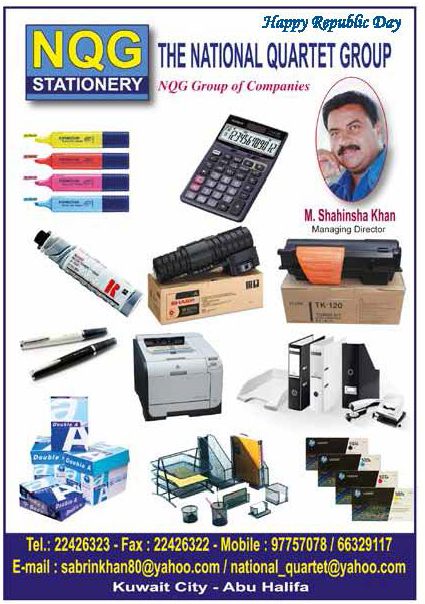 In this context one should note the communication revolution which the mobile telephone has brought about in India. There are now over 900 million mobile subscribers in the country and this number continues to grow each year . They also constitute a platform for connectivity, creating new markets, connecting producers to consumers more efficiently and enabling vast amounts of data to flow seamlessly across communities. This can and is having a multiplier effect on economic activity through the closer proximity it creates.
In this context one should note the communication revolution which the mobile telephone has brought about in India. There are now over 900 million mobile subscribers in the country and this number continues to grow each year . They also constitute a platform for connectivity, creating new markets, connecting producers to consumers more efficiently and enabling vast amounts of data to flow seamlessly across communities. This can and is having a multiplier effect on economic activity through the closer proximity it creates.
Moving on to our sub-continental neighbourhood, it remains true that our countries are even less connected with each other today than in 1947. Several major transport arteries, including rail, road and water transport, were all interrupted after the partition of India in 1947. Even though some cross-border transport linkages are being re-established with both Bangladesh and Pakistan, they are not generating the benefits they should because of cumbersome customs, immigration and security procedures at border crossing points. Cargo movement is also held up due to lack of accompanying banking, testing and inspection facilities. These issues are now being addressed through an ambitious Indian plan to set up a network of Integrated Checkpoints (ICP) on borders with neighbouring countries. These ICPs which are being set up by the newly constituted Land Port Authority of India ( LPAI ), will incorporate, at one location, immigration, customs, security,warehousing, phyto-sanitary testing facilities as also banking and exchange facilities. There would be adequate parking, boarding and lodging and health facilities for the welfare of traders, truckers and other categories of travellers. One such ICP has already been set up at Attari on the India-Pakistan border. Several others are in various stages of implementation on India’s borders with Nepal, Bhutan, Bangladesh and Myanmar. The ICP at the Tamu-Moreh border point on the India-Myanmar border is already under construction. The back-end linkages in terms of modern highways and, where necessary railway connections are also being put in place with these countries mainly through Indian funding. Of special note in this regard are the proposed Trilateral Highway connecting India, Myanmar and Thailand and the Kaladan Multi-Modal Transport project linking the Myanmar port of Sittwe with Mizoram in our North-East and with Kolkata across the Bay of Bengal. Several highways across the India-Nepal and India-Bhutan borders are being upgraded and new rail links are planned. These transport links will bring closer the vision of a South Asia where there is a free flow of goods, peoples and ideas transcending political boundaries.
Leaders of South Asia have declared the decade of 2010-2020 as the Decade of Connectivity in the region. That in itself is a major step forward because it represents a political consensus on the importance of connectivity for shared prosperity. Two landmark agreements have been negotiated and are ready for adoption. One is the Motor Vehicles agreement and the other is a Railways agreement. When implemented, these agreements will go a long way in enabling the smooth movement of goods and peoples across national boundaries.
India has also given priority to its connectivity with ASEAN countries. The India-Myanmar transport projects are important because Myanmar is India’s gateway to South-East Asia. ASEAN has its own connectivity plan and India is working to align its own transport infrastructure development plans with ASEAN. These include cross-border rail and road connectivity, maritime , air and digital connectivity. These must be accompanied by better logistics and efficient border clearances. Only then would it be possible for India to participate in the regional and global value chains which are already highly developed in ASEAN and Asia-Pacific in general.
Ultimately what is required is a mind-set change in India. We must start looking at national boundaries not as impenetrable walls behind which we must protect ourselves from hostile influences beyond, but rather as “connectors”, bringing India closer to its neighbours and through them, the region and world . Cross- border links then become transmission belts for the free flow of development impulses. Transport corridors thus become economic corridors. Through much of its history, India was a flourishing civilisation, leveraging its geographical location at the cross-roads of the ancient caravan routes connecting to Central Asia. Thanks to its peninsular character , lying astride the Indian Ocean, India was also at the centre of the monsoon-driven ocean routes both to the East and the West. India flourished because it was a connected nation. India’s future lies in learning the lessons from its own cosmopolitan past.
( Shyam Saran is a former foreign secretary, is currently chairman of the National Security Advisory Board and RIS, as well as a senior fellow at the Centre for Policy Research in New Delhi )
Gods of Zero and Infinity
- Devdutt Pattanaik
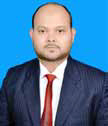
MOHAMMED KHAN
Partner Kuwait Import Gen. Trad. & Cont. Est
It would be difficult to conclude that whether India has really achieved anything substantial since the first Republic Day. While there has been progress and development and the people have more money to use, there is shortage of genuine happiness and security. At present, education is like a business, in the name of school fees and donation, they are collecting huge amount, poor people and middle class people are struggling a lot because of this new business. Everywhere, corruption (even in police stations), rape attempts (even in schools and colleges), poverty, Robbery, and murders (everywhere) We have to change these minus points into plus and to change our Nation as the best Democratic country in the world without the above said minus points.
Happy Republic day! JAI HIND…..!
For Hindus, the world is created when Narayana awakes. Narayana is the god reclining on the serpent with multiple-hoods. When he is in dreamless slumber, the world does not exist. When he awakens, the world comes into being. Narayana is thus a visual representation of human consciousness, which awakening heralds the creation of our world.
What is interesting is the serpent on whose coils Narayana reclines. Its name is: Adi-Ananta-Sesha, which literally means Primal-Limitless-Residue, which is numerically visualised as One-Infinity-Zero. For with consciousness, we become aware of the first moment of beginnings, of limitless possibilities, and of nothingness that existed before the first moment.
The Hindu worldview has always been obsessed with infinity (everything-ness) and zero (nothingness) and with the number one (the beginning). More than Hindu, it is the Indic worldview, the substratum of thought which gave rise to three major ideas: Hinduism, Buddhism and Jainism, all of which speak of rebirth, cyclical time, and a world where there are no boundaries. Buddhism came up with ideas such as nirvana (oblivion) and shunya (which literally means zero). Jainism spoke of a world of endless possibilities (an-ekanta-vada).
This is in stark contrast to the Greek worldview where the world begins as chaos until the gods create order. And with order comes definitions, boundaries, certainty, and predictability. It is also different from the Abrahamic worldview where God creates the world out of nothingness and the world he creates in seven days has a definite expiry date: the Apocalypse. The Greek and Abrahamic worldviews inform what we call the Western worldview today that is obsessed with organisation, and is terrified of disorder, and unpredictability, something Indians are used to and rather comfortable with, even thriving in it.
The story goes that when Alexander, the Great, after having conquered Persia, visited India, he met a sage on the banks of the river Indus, who he referred to as a gymno-sophist or naked wise man, in Greek. This sage sat on a rock and spent all day staring at the sky. Alexander asked him what he was doing and the sage replied, “Experiencing nothingness.” The sage asked Alexander what was he doing. Alexander replied, “I am conquering the world.” Both laughed. Each one thought the other was a fool. For Alexander, the sage was wasting his one and only life doing nothing. For the sage, Alexander was wasting his time trying to conquer a world that has no limits, with a sense of urgency that made no sense when one lives infinite lives. Belief in one life, which is the hallmark of Greek worldview, and later Abrahamic, results us in valuing achievements. But belief in rebirth, hence infinite lives, which is the hallmark of Indic worldview, makes achievements meaningless, and puts the focus on wisdom and understanding. When the denominator of life is one, the world is different from when the denominator of life is infinity.
India’s philosophical obsession with infinity and zero led to mathematicians not just conceptualising the idea of zero, but also giving it a form (a dot), and finally using it in a decimal system. This happened around the same time that the Gupta kings built the temple in Deogarh. The mathematician Brahmagupta, 638 AD, is associated with giving form to the number zero, and formulating the first rules with its usage. The rise of the decimal system enabled the writing of vast numbers, of huge value, a practice that has been traced to even Vedic texts written around 1000 BCE, values that are not seen in any other parts of the world.
The Arab sea-merchants who frequented the coasts of India, and who dominated the rich spice and textile trade then (before the European sea-farers took over in the 16th century) saw value in this system and took it with them to Arabia. The Arab mathematician Khowarizimi suggested use of a little circle for zero. This circle was called ‘sifr’ which means ‘empty’, which eventually became ‘zero’. Zero travelled from Arabia through Persia and Mesopotamia to Europe during the Crusades. In Spain, Fibonacci found it useful to do equations without using the abacus. Italian government was suspicious of this Arabic numbering system and so outlawed it. But the merchants used it secretly, which is why ‘sifr’ became ‘cipher’, meaning ‘code’.
It comes as a shock to many people that the modern use of the number zero is less than thousand years old, and that it became popular less than 500 years ago. Had it not been for the arrival of zero, neither would the Cartesian coordinate system nor calculus have developed in the 16th century. Zero enabled people to conceptualize large numbers and helped in book keeping and accounting. In the 20th century, came the binary system which forms the foundation of modern computing. All because some wild Indian sages conceptualised the universe and their gods in terms of zero and infinity.
Devdutt Pattanaik is author of over 30 books and 400 articles on relevance of mythology in modern times. A 2009 TED speaker, he is renowned for drawing attention to the Indian consequence-based approach to management, quite distinct from objective-based modern management . To know more about him visit devdutt.com
India - The Wonder Republic @ 65
- S. Y. Quraishi
Think India, and two words spring up in mind – Democracy and Republic. That India is the world’s largest republic is common knowledge. What, however, is lesser known is that republic is in India’s DNA.
 We had republics in India prior to the oldest known republics like classical Athens (508 – 322 BC) and Roman Republic (c.509 – 27 BC). Many Indian republics preceded these, most notably the Vaijjian confederacy in Vaishali (in Bihar) around 600 BC in the times of Lord Buddha. Since then, we have recurring evidence of republics in India. In 1830, Sir Charles Metcalfe, the then acting Governor General of India wrote, “The village communities are little republics, having nearly everything they want within themselves and almost independent of any foreign relations.” It is these self contained, self governing village republics that have ensured the continuity and survival of the the great Indian civilisation which even the mightiest of empires could never penetrate.
We had republics in India prior to the oldest known republics like classical Athens (508 – 322 BC) and Roman Republic (c.509 – 27 BC). Many Indian republics preceded these, most notably the Vaijjian confederacy in Vaishali (in Bihar) around 600 BC in the times of Lord Buddha. Since then, we have recurring evidence of republics in India. In 1830, Sir Charles Metcalfe, the then acting Governor General of India wrote, “The village communities are little republics, having nearly everything they want within themselves and almost independent of any foreign relations.” It is these self contained, self governing village republics that have ensured the continuity and survival of the the great Indian civilisation which even the mightiest of empires could never penetrate.
Today the biggest republic of the world envelops in itself half a million tiny village republics managing their affairs through self governance called the Panchayati Raj ( the rule of the village community). India now basks in 64 years of republican glory. It will be interesting to retrospect over these momentous years.
A vibrant electoral democracy has been India’s most enduring and endearing identity ever since India adopted a great constitution that made it a democratic republic with universal adult suffrage. This was considered by the developed countries as afoolhardy misadventure. Their skepticism was based on the ground realities of the time. India had just got devastated by a deadly partition in which millions of lives were lost. It was an unequal, fractured caste based hierarchical society with 84% illiteracy and extreme poverty. How will they rule themselves?
The prophets of doom were silenced before long. India took to democracy like fish takes to water.
Adjusting itself to the new environment of freedom and democracy in no time. India went on to prove Nobel laureate Amartya Sen’s famous statement that a country does not become fit for democracy, it becomes fit through democracy.
Over the past sixty four years, the Election Commission of India has delivered sixteen elections to the Lok Sabha (the House of the People) and over 360 elections to State Legislative Assemblies without missing a single deadline. Peaceful, orderly and democratic transfer of power has been the envy of the entire democratic world. The outgoing prime minister ( or chief minister) offering the chair to the incoming one with humility and folded hands has been a sight which many democracies only long to see.
PM Modi called on the outgoing PM Manmohan Singh just after taking his oath of office. ( www.cuurentnewsofindia.com)
The fourteenth General Election in May 2014, was the biggest election in world history. As many as 554 million of 834 million registered voters exercised their franchise at 931,986 polling booths on 1.8 million electronic voting machines (EVMs). In sheer size, the Indian electorate is bigger than the combined voter population of each continent. In fact, it is like 90 countries rolled into one, not just in terms of numbers alone but the complexities as well.
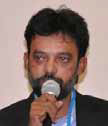
MOHAMMED GHOUSE
Partner,Velldon Real Agencies
We must have an undiluted commitment to stability, honesty, and the development of India. Our problems will not disappear overnight. We live in a turbulent part of the world where factors of instability have grown in the recent past. Communal forces will still seek to destabilize the harmony of our people and the integrity of our state, but they will never win. Our security and armed forces, backed by the steel of popular support, have proved that they can crush an enemy within; with as much felicity as they guard our frontiers. India’s true strength lies in her Republic; in the courage of her commitment, the sagacity of her Constitution, and the patriotism of her people.
Happy Republic day!
And the numbers are always growing. GE 2014 saw the addition of over 118 million voters since the last General Election in 2009. In terms of the voting population, this is like adding an entire Pakistan, or South Africa and South Korea combined, or three Canadas, or four Australias, or 10 Portugals or 20 Finlands!
India is undoubtedly the most diverse country in the world -multi-religious, multi-cultural, multi-lingual, and multi-ethnic, besides geographical diversity (deserts, mountains, plains, forests, islands, and coastal areas). We have all the world's major religions, 22 official languages and 780 spoken languages. The demands of this diversity can be mind boggling. Equally difficult are the other challenges of fighting terrorism, security threats, adjusting to globalisation and rising expectations of IT savvy growing middle class.
Inclusion and Participation the key features of the republic
Elections can be truly free and fair only if these are inclusive, socially just and participative. During the sixty four years of our democratic history, the voter turnout has remained around 55-60%, definitely far less than what ECI aspires to achieve. To address this, ECI came up with a Systematic Voters’ Education and Electoral Participation (SVEEP) wing that rolls out multi-media campaigns to bring all citizens, especially the urban upper and middle class, the youth and women, into electoral participation. Dramatic results followed. During the last four years every state and the national election saw record turnouts, in most cases highest in history!
National Voters Day was one of the highlights of the programme focussing on the youth turning 18. A drive was launched to locate such youth well in advance and on 25 January ( the founding day of the ECI) at felicitations organised at all the 800,000 polling stations to be celebrated as the National Voters Day (NVD).
The first NVD was inaugurated by the President of India on 25 January 2011, in the presence of Chief Election Commissioners of over thirty countries. The beauty of the programme is that for this countrywide celebration, not a single extra rupee was demanded. We used the normal funds for electoral registration activities but converted it into a major national ‘event’. Many countries evinced interest in this unique, zero cost but effective model and some subsequently adopted it.
Use of Technology
Managing elections in a country of subcontinental dimensions cannot be done easily without the application of every possible technology. This has brought great efficiency in the electoral process. These technologies are rigorously field- tested before adoption to ensure absolute reliability. We have seen many elections in several countries collapsing because of hasty introduction of untested technology.
EVMs: The Wonder Machine of Indian Democracy
 EVMs have been used in all elections to Parliamentary and Legislative Assembly constituencies since November 1998. It has revolutionised counting, making it quick, peaceful, efficient and free from invalid votes. The counting day disputes and tensions have just disappeared. No surprise that it has come to be described as a wonder machine of Indian democracy. Many countries have adopted these like – Bhutan, Nepal and Namibia with many more studying it in depth.
EVMs have been used in all elections to Parliamentary and Legislative Assembly constituencies since November 1998. It has revolutionised counting, making it quick, peaceful, efficient and free from invalid votes. The counting day disputes and tensions have just disappeared. No surprise that it has come to be described as a wonder machine of Indian democracy. Many countries have adopted these like – Bhutan, Nepal and Namibia with many more studying it in depth.
EVMs have undergone frequent updation. The latest innovation is the addition of a voter verifiable paper audit trail (VVPAT). VVPAT allows voters to verify that their vote was cast correctly, and to provide a means to audit the stored electronic results. Now we have the most transparentand credible voting system in the world.
Four hallmarks characterise the way in which the ECI handles the mammoth task: independence, transparency, neutrality and professionalism.That ensures full public trust in the Commission.
A distinctive new feature of the last general election was the significant role played by the New Media, including mobile telephony and social media, in any election for the first time. Some went so far as to call social media the new election 'battleground' and GE 2014 the first social media election.
Conclusion:
One of the secrets of the success of the Election Commission of India is its openness to new ideas and to learning from its mistakes and achievements. We, therefore, expect that every election is better than the previous best. EC's efforts in pursuit of excellence must go on. Not just India but the world has a great stake in the success of democracy in the region.
Realising that that the aspiring democracies around the world look forward to sharing the knowledge, skills and expertise at ECI’s disposal, the Commission set up the India International Institute of Democracy and Election Management (IIDEM), as a training and resource centre in elections and democratic processes for both national and international participants. In just three years of its existence, the institute has imparted training to election managers of over fifty Afro Asian and Commonwealth countries, besides thousands of domestic master trainers. The Institute has now become a training hub for assisting representative democracy worldwide.
A stage has come in India when holding a free and fair election is taken for granted. In fact not holding one would be news. We must not let that happen. This is India’s promise to its own people and to the world.
[ SYQuraishi, a former civil servant, was the 17th Chief Election Commisssioner of India. His earlier postings included Secretary Ministry of Sports and Youth Affairs, DG, National AIDS Control Organisation ( NACO), DG, Doordarshan, the world's largest national broadcaster, et al. ]
- Bhaswati Mukherjee
Background
India’s intangible cultural heritage flows from her 5000 year old culture and civilisation. Dr. A.L. Basham, in his authoritative “Cultural History of India”, has noted that “While there are four main cradles of civilisation which, moving from East to West, are China, India, the Fertile Crescent and the Mediterranean, specially Greece and Italy, India deserves a larger share of credit because she has deeply affected the cultural life of most of Asia. She has also extended her influence, directly and indirectly, to other parts of the World.”
2. The civilisation that developed in the Valleys of our two great river systems, the Indus and the Ganges, although in a sharply demarcated geographical region due to the Himalayas, was complex, multi-faceted and was never an isolated civilisation. The notion that before the impact of European learning, science and technology, the ‘East’ including China and India changed little if at all, over the centuries is false and should be rejected. Indian civilisation has always been dynamic, not static. Settlers and traders came to India from the land and sea routes. India’s isolation was never complete, from the most ancient times. This resulted in the development of a complex pattern of civilisation, demonstrated so clearly in the intangible art and cultural traditions ranging from Ancient to Modern India, whether in the dancing Buddhas of the Gandharva school of art which was strongly influenced by the Greeks, to the great tangible heritage seen in the temples of North and South India.
3. It is no surprise that India's diversity has inspired many writers to pen differing perceptions of the country's culture. These writings paint a complex and often conflicting picture of the culture of India. The best definition has been provided by Dr. Amartya Sen, the Indian Nobel Laureate in Economics. According to him, the culture of modern India is a complex blend of its historical traditions, influences from the effects of colonialism over centuries and current Western culture - both collaterally and dialectically. Western writers usually neglect, in important ways, crucial aspects of Indian culture and traditions and its diversities. The deep-seated heterogeneity of Indian traditions, in different parts of India, is lost in these homogenised descriptions of India. India is not and can never be a homogenous culture. The best example is her intangible heritage.
4. A pen sketch on this subject cannot be complete without recalling E.H. Carr’s chapter 1 on ‘What is History’. Carr pointed out that facts do not speak for themselves. They speak only when the historian calls on them to speak. It is the historian who decides which fact to give and therefore the historian is necessarily selective. Thus Carr concludes that “History is a continuous process of interaction between the historian and his facts, an unending dialogue between the present and past, a dynamic, dialectical process, which cannot be limited by mere empiricism or love of facts alone”. This demonstrates the complexity of the task of interpreting this intangible heritage historically and in an objective manner.
5. It is clear that Intangible Cultural Heritage such as the Indian example, is difficult to explain or interpret, because of its complexity. Tangible heritage on the other hand, being more visible is much better understood. The best definition of Intangible Cultural Heritage is contained in the 2003 UNESCO Convention on ICH which defines it in a manner broad enough to include diverse experiences and expressions across the globe such as “the practices, representations, expressions, knowledge, skills as well as the instruments, objects, artifacts and cultural spaces associated therewith – that communities, groups and, in some cases, individuals recognised as part of their cultural heritage”. This is an excellent definition of India’s great spiritual and cultural intangible heritage.
Definition of ICH

6. What is Intangible Cultural Heritage? Heritage does not end at monuments or collection of objects of arts. It also includes traditions or living expressions inherited from our ancestors and passed on to our descendents, such as oral traditions, performing arts, religious and cultural festivals and traditional crafts. This Intangible Cultural Heritage, by its very nature, is fragile and needs protection and understanding since it is an important factor in maintaining cultural diversity in the face of growing globalisation. Developing understanding of the ICH of different communities, such as in India, helps the process of an international, inter-cultural dialogue and promotes, in the long run, international peace and security.
7. ICH is best defined as:
• Traditional, contemporary and living at the same time, since it is a dynamic process;
• Inclusive since it contributes to social cohesion, encourages a sense of identity and helps to preserve communities and community ife;
• Representative since it prospers on oral skills passed on from generation to generation;
• Community based since it can be defined as heritage only when it is recognised as such by the communities, groups or individuals that create, maintain and transmit it.
ICH therefore, based on the above definition, is important not as a cultural manifestation as such but rather on the wealth of knowledge and skill that are transmitted through it from one generation to another. The social and economic value of this transmission of knowledge is as significant for developed countries as for developing countries.
Festivals such as Holi : A Case Study of ICH
8. Holi’s historical origins date back to pre-Christian times. Paganism and Pagan festivals, based on pre-Christian rituals and ‘Bacchus’ traditions were frowned upon by the earliest Christians and soon disappeared. Only the Christian mistletoe traditions have survived. Similarly, the rituals of Holi date back to the earliest times based on social traditions. Hindu rituals, myths and legends came later. Religious and cultural festivals, such as Holi, express the heart of the people, reflecting their culture and identity. Several of the world’s best known festivals exist in India. Many of them are rooted in India’s diverse culture and civilisation. Thus the historic origins of Holi, originally known as ‘Holika’, find detailed description in India’s earliest religious epics and works such as Jamini’s Purvamimamsa-Sutras and Kathaka-Grhya-Sutras. Eminent Indian historians believe that Holi was celebrated by Aryans who came to India from Central Asia in 5000 BC. Thus, Holi existed several centuries before Christ. There are also many references to Holi in India’s ancient archaeological remains.
9. Since ICH is a dynamic process, the meaning of the Festival has changed over the years. It also has different manifestations in different parts of India. Even these myths and legends are diverse and reflect India’s fascinating intangible heritage. All over India, the festival celebrates the victory of good over evil and also the triumph of devotion to God.
10. Holi is thus linked with folklore and folk culture and binds communities together. One example is the Chhau dance. This dance form is a tradition from the Eastern part of India, specially Bihar, which enacts episodes from the Epics, including Mahabharata and Ramayana, local folklore and abstract themes. Its three distinct styles hail from the regions of Seraikella, Purulia and Mayurbhanj, in Eastern India. Chhau dance is intimately connected to regional festivals, notably the spring festival Chaitra Parva. Its origin is traceable to indigenous forms of dance and martial practices. Its vocabulary of movement includes mock combat techniques, stylized gaits of birds and animals and movements modelled on the chores of village housewives. It represents a transitional stage in the development of unsophisticated forms of folk dance to highly stylised forms. The Chhau is one of the earliest indigenous form of dances in India. These practices demonstrate that in India, living continuity with the past, is an important criterion for its heritage. These folk cultures, therefore, are part of India’s age-old intangible cultural heritage.
Some Concluding Reflections
11. In India, we are the repository of an astounding wealth of living patterns and modes of heritage. With about 1400 dialects and 18 officially recognized languages, several religions, various styles of art, architecture, literature, music and dance, and several lifestyle patterns, India represents the largest democracy with a seamless picture of diversity in unity, perhaps unparalleled anywhere in the world.
12. Through a history of changing settlements and political power, India’s living cultural heritage was shaped by centuries of adaptation, re-creation and co-existence. The intangible cultural heritage of India finds expression in the ideas, practices, beliefs and values shared by communities across long stretches of time, and form part of the collective memory of the nation. India’s physical, ethnic and linguistic variety is as staggering as its cultural pluralism, which exists in a framework of interconnectedness. In some instances, its cultural heritage is expressed as pan-Indian traditions not confined to a particular locality, genre or category, but as multiple forms, levels and versions inter-linked yet independent from one another. Underlying the diversity of India’s heritage is the continuity of its civilization from the earliest times to the present and of the later additions by different influences.
13. In concluding, it may be pertinent to recall that Swami Vivekananda had said:
“If anyone dreams of the exclusive survival of his own religion and culture, I pity him from the bottom of my heart and point out that upon the banner of every religion and culture will soon be written in spite of resistance, “Help and not Fight; Assimilation and not Destruction; Harmony and Peace and not Dissension”.
This symbolises what India brings to the world, its living intangible heritage which is its global civilisational heritage. This heritage would help to maintain a cultural and civilizational dialogue between peoples and societies and cultures. This in its turn would be a powerful lever for renewing the international community’s strategy towards development and peace. [ Bhaswati Mukherjee is a former diplomat was Permanent Representative of India to UNESCO (2004-2010). ]
-- Pallava Bagla
The success of India’s maiden mission to Mars is hailed as a global landmark as it paves the way for cheap and reliable inter-planetary travel, this has been possible only because of a robust high technology infrastructure that has been put in place by the country. The same is also true in the sector of atomic energy where India’s prowess is slowly being recognized so much so that in the world’s only fusion energy reactor being constructed in France, India is a full member. Today, the country’s Mars Orbiter Mission (MOM) truly symbolizes `Make in India’.
Speaking at the `Make in India’ workshop on December 29, 2014 The Prime Minister Narendra Modi said `Human Resource Development, Innovation and Research should become part of the Government's DNA. He said these should be aligned to the nation's overall goals in various sectors.’Modicalled upon all sectors of manufacturing in India to take inspiration from the "Space" sector, and the achievements of India's space scientists.
On his recent visit to New York where Prime Minister had the crowd in raptures as he repeatedly brought up India’s success of reaching Mars. Modi said `everything about Mangalyaan is indigenous,… made in small factories. We reached Mars at a smaller budget than a Hollywood movie," he said adding "India is the only country to reach Mars on its first attempt. If this is not talent, then what is?’
 Not many know that the darling of the masses, Mangalyaan is truly also the flag bearer for Modi’s `Make in India’ campaign where he is pitching for India becoming the hub for making `satellites to submarines’. India Incorporated a website dedicated to promoting India’s strengths highlighted that `some 40 industries aredirectly involved in the making of the spacecraft itselfthat was put together by the Indian Space Research Organisation (ISRO). From small firms like Sangvi Aerospace Pvt Limited from Ahmedabad that supplied the wires and cables to giants like L&T and Godrej, to Technocom in Rajkot which helped with the camera that gave MOM its first view of Mars. All truly symbolize the humble `made in India’ tag that Mangalyaan carries.’
Not many know that the darling of the masses, Mangalyaan is truly also the flag bearer for Modi’s `Make in India’ campaign where he is pitching for India becoming the hub for making `satellites to submarines’. India Incorporated a website dedicated to promoting India’s strengths highlighted that `some 40 industries aredirectly involved in the making of the spacecraft itselfthat was put together by the Indian Space Research Organisation (ISRO). From small firms like Sangvi Aerospace Pvt Limited from Ahmedabad that supplied the wires and cables to giants like L&T and Godrej, to Technocom in Rajkot which helped with the camera that gave MOM its first view of Mars. All truly symbolize the humble `made in India’ tag that Mangalyaan carries.’`Space is the last frontier so push and push some more’ was part of Prime Minister Narendra Modi’s pitch to India space scientists when he came to the partake in the joys and sorrows of the small 16,000 strong space community that made India proud by hitting bull’s eye in the very first attempt of reaching planet Mars. A feat not achieved even by great space powers like USA and America. Acknowledging India’s achievement NASA Administrator Charles Bolden called it `an impressive engineering feat’.
Another 100 or so industries are directly involved with the making of the rocket that launched MOM into space on November 5, 2013.
What caught the attention of the world was the relatively small cost of the mission Rs 450 crores or about $ 75 million, which is ten times cheaper than the NASA’s latest mission that reached Mars two days ahead of India’s. This was undoubtedly the lowest cost inter-planetary mission ever to be undertaken in the twenty-first century. As ISRO chairman K. Radhakrishnan says `modularity’ of sub-systems helps reduce costs and the low wage bills alongside the long hours put in by ISRO’s 500 work force that worked on the Mars satellite helped keep the cost very low.
On June 30, Modi watched the majestic lift-off of the 114 Indian mission of the Indian space agency the launch of the Polar Satellite Launch Vehicle that has till date launched 40 satellites from as many 19 different countries. ISRO’s commercial arm the Antrix Corporation Limited has an annual turnover of about Rs 15,000 million and it has already procured orders for three more dedicated commercial launches using the PSLV, which will place in orbit another 14 foreign satellites in the coming years. V S Hegde, Chairman and Managing Director of Antrix Corporation Limited says `we are already a force to be reckoned with and we are definitely going to grow’.
Reaching for the stars is not the only frontier where India’s efforts are bearing fruit, tapping nuclear energy is also a big aspirational dream for India. India today is contributing actively in world’s largest science project to generate fusion energy.
Evergreen atomic energy a possibility!
A star is set to be born in southern France, a humongous over $ 20 billion effort is being made to make a nuclear reactor like never before, a special steel cauldron where fusion energy could be tapped and it is called the International Thermonuclear Experimental Reactor (ITER). Ratan Kumar Sinha Chairman of the Atomic Energy Commission says `fusion energy holds the promise of becoming an unlimited source of environment friendly energy for the world.’
This is till date world’s largest scientific project ever to be undertaken and it is getting off the ground in Europe, a mammoth project that experts say will pave the way for generating unlimited clean nuclear energy by fusing atoms, a process not very different from what happens on the Sun.
The reactor will weigh about 23,000 tons the equivalent of the weight of 3 Eiffel Towers in Paris. Some 80,000 kilometres of special super conducting wires will be used.
Six nations India, China, South Korea, USA, Japan, Russia and the European Union have joined hands as equal partners to see if they can jointly harness the power of the Sun by literally confining it in a steel bottle.
Within the massive steel frame gas will be heated to over 150 million degrees temperature and it will be confined into a limited space using giant magnets, some atoms will then fuse together releasing huge amounts of heat which can then be directed to run turbines to generate electricity. In the first instance, it is hoped the fusion reactor will produce ten times more energy than what is used to initiate the reaction estimated to produce the equivalent of 500 MW of power.
But it is easier said than done since taming the power of the Sun is a Herculean task and for the last half a century scientists have dreamt about this feat but it was only in 2006 that the ITER organisation come into being when things started become real.
India’s role
India is a full member of this enterprise providing about ten percent of the components for the massive nuclear complex unfolding at Cadarache in France. New Delhi is contributing what would when completed in 2021 would be world’s largest refrigerator. It also acts like a thermos flask but operates at some of the coldest temperatures ever seen in the universe working at minus 269 degrees Celsius (-269 degrees Celsius) and technically called a `cryostat’, it is being made to order for the Department of Atomic Energy by L&T Industries. M V Kotwal, President, Heavy Engineering L&T industries, Mumbai says `manufacture & installation of the cryostat has been entrusted to L&T. Work on this project is already in progress in our Hazira Manufacturing Complex. We have also constructed a special workshop at the site in Cadarache, France to enable site assembly of the large & complex stainless steel structure from components which will be supplied from Hazira in India.’
India will make in-kind investment probably totalling about Rupees 9000 crores over the next decade thus contributing about 9.1% of the share of the total costs.
Sinha says ‘participation of India in the ITER project, with its immense scientific talent and industrial competence, has provided an opportunity to India to master the cutting edge technologies manifest in this massive project. In the near term, it has facilitated a huge impetus to scientific research, manpower development and building an internationally competitive industrial capability within Indian private sector in the highly advanced field of fusion energy’.
Once the proof is established that mankind can harness the power of the Sun, India could well build its own fusion reactors possibly very soon after 2050, thus providing unlimited energy.
Modi said ISRO has made it a habit of `making the impossible possible’. So could India, literally pave the way for cheaper, durable and reliable satellites in the `Make in India’ movement that Modi has flagged off. A multi-billion dollar space and nuclear energy market is waiting to be tapped.
In this bold new initiative Modi called for making a globally recognized "Brand India" famous for "Zero Defect, Zero Effect" Manufacturing – free from defects, and with no adverse impact on the environment.
Pallava Bagla
(Pallava Bagla an eminent science writer is co-author of the book `Reaching for the Stars: India’s Journey to Mars and Beyond’ published by Bloomsbury India. He can be reached at pallava.bagla@gmail.com and Twitter: pallavabagla)
 |
 |
| (India’s highly successful maiden mission to Mars, is the cheapest inter-planetary mission till date costing less than $ 75 million and truly a remarkable example of `make in India’. Seen here is the lift off the Mangalyaan on November 5, 2013 using the indigenously made Polar Satellite Launch Vehicle (PSLV) sent into space from India’s spaceport at Sriharikota on the coast of the Bay of Bengal. Credit: ISRO) | (India’s satellite that orbits Mars, seen here when it was being integrated. Mangalyaan hit bull’s eye and created world history making India the first country to reach Mars in its debut attempt. Credit: ISRO) |
 |
 |
| (India is a full member of the world’s largest scientific experiment to make a fusion energy reactor coming up at Cadarache in France.) | (At the International Thermonuclear Experimental Reactor (ITER) being made at France the world’s largest refrigerator is being made by India, a truly `make in India’ initiative. Credit: ITER) |







